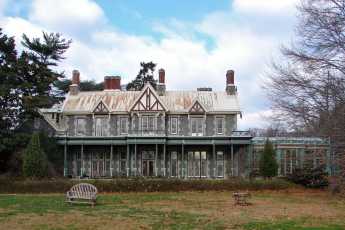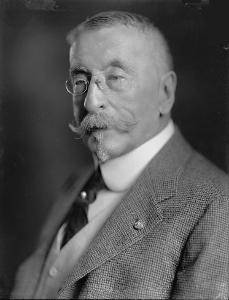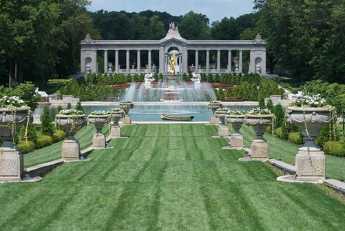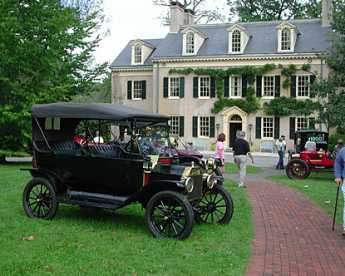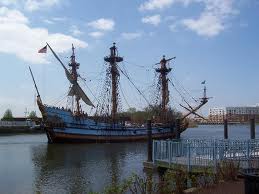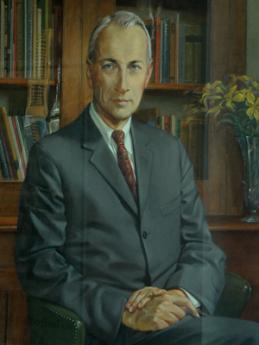4 Volumes
Tourist Trips: Philadelphia and the Quaker Colonies
The states of Pennsylvania, Delaware, and New Jersey all belonged to William Penn the Quaker in one way or another. New Jersey was first, Delaware the last. Penn was the largest private landholder in American history.
Revolutionary War Era
The shot heard 'round the world.
Regional Overview: The Sights of the City, Loosely Defined
Philadelphia,defined here as the Quaker region of three formerly Quaker states, contains an astonishing number of interesting places to visit. Three centuries of history leave their marks everywhere. Begin by understanding that William Penn was the largest private landholder in history, and he owned all of it.
Surviving Strands of Quakerism
Of the original thirteen, there were three Quaker colonies, all founded by William Penn: New Jersey first, Pennsylvania biggest, and Delaware so small Quakerism was overcome by indigenous Dutch and Swedes.
Delaware (State of)
 Originally the "lower counties" of Pennsylvania, and thus one of three Quaker colonies founded by William Penn, Delaware has developed its own set of traditions and history.
Originally the "lower counties" of Pennsylvania, and thus one of three Quaker colonies founded by William Penn, Delaware has developed its own set of traditions and history.
 The three counties of the state of Delaware were once the "lower three counties" of Pennsylvania, who split off fairly peaceably during the Revolutionary War. They were only separate in the first place because the boundaries were vague and perhaps carelessly drawn. Maryland had been given to Lord Baltimore by the first King Charles, with its upper border stated to be the 40th parallel, which is roughly the point on the Delaware River where the Tacony Palmyra Bridge crosses. The second King Charles gave William Penn land down to twelve miles north of New Castle. And since King Charles II's brother James, the Duke of York, was left with a remnant of all the land from the Connecticut River to Cape Henlopen, from which the State of New Jersey had been removed as a reward to George Carteret and John Berkeley, he hastily signed it over to William Penn a day or two before he was exiled. When the smoke cleared a little, it became obvious these were impossible requirements to reconcile, and a long court battle finally gave Delaware and Pennsylvania to William Penn, who already had effective control of New Jersey through his control of a proprietorship which bought out the Carteret/Berkeley holdings. The line of Mason and Dixon finally became dominant, although not without surveying, hence legal, mishaps along the way. During a long period of uncertainty, the residents of Delaware became accustomed to feeling independent, and Penn let them have their own legislature with a single governor jointly with Pennsylvania. He made the remark that his only interest was to give Philadelphia clear access to the sea, but in fact lost interest as a result of personal troubles and lawsuits.
Many have commented that the State of Delaware is a lawyer's paradise. If so, its own long history of legal disputes probably set the tone long before it was definitively created.
The three counties of the state of Delaware were once the "lower three counties" of Pennsylvania, who split off fairly peaceably during the Revolutionary War. They were only separate in the first place because the boundaries were vague and perhaps carelessly drawn. Maryland had been given to Lord Baltimore by the first King Charles, with its upper border stated to be the 40th parallel, which is roughly the point on the Delaware River where the Tacony Palmyra Bridge crosses. The second King Charles gave William Penn land down to twelve miles north of New Castle. And since King Charles II's brother James, the Duke of York, was left with a remnant of all the land from the Connecticut River to Cape Henlopen, from which the State of New Jersey had been removed as a reward to George Carteret and John Berkeley, he hastily signed it over to William Penn a day or two before he was exiled. When the smoke cleared a little, it became obvious these were impossible requirements to reconcile, and a long court battle finally gave Delaware and Pennsylvania to William Penn, who already had effective control of New Jersey through his control of a proprietorship which bought out the Carteret/Berkeley holdings. The line of Mason and Dixon finally became dominant, although not without surveying, hence legal, mishaps along the way. During a long period of uncertainty, the residents of Delaware became accustomed to feeling independent, and Penn let them have their own legislature with a single governor jointly with Pennsylvania. He made the remark that his only interest was to give Philadelphia clear access to the sea, but in fact lost interest as a result of personal troubles and lawsuits.
Many have commented that the State of Delaware is a lawyer's paradise. If so, its own long history of legal disputes probably set the tone long before it was definitively created.
Delaware Bay Before the White Man Came
Captain John Smith of Virginia, sometime friend of Pocahontas, wrote a letter to Captain Henry Hudson that he understood there was a big gap in the continent to the North of the Virginia Capes, and maybe this was the Northwest Passage to China. Hudson set out to look for it.

|
| Hudson |
Smith's misjudgment now seems like a credible story if you take the ferry from Lewes, Delaware to Cape May, New Jersey. You are out of sight of land for half an hour on that trip, and it's a hundred miles of blue salt water to Philadelphia if you decided to go in that direction. In fact, the bay widens out to double the width or more, just inside the capes, and you can see how an explorer in a little sailboat might believe there was clear sailing to the Indies if you went that way. But as a matter of fact, Hudson encountered so much "shoal" that he ran aground repeatedly trying to sail into the bay, and soon gave up. He encountered a swamp, not an ocean passage. The Hudson River, and later Hudson's Bay, seemed like better bets.
What Hudson had encountered was one of the largest gaps in the chain of Atlantic barrier islands, formed by the crumbling of the Allegheny Mountains into the sea, and then washed up as beach islands by the ocean currents. At various points, the low flat sandy islands became re-attached to the mainland as the intervening bay silted up, and that's why the islands of New Jersey and Delaware seem like part of the mainland. And that's what would have happened to the whole Delaware Bay if it hadn't been ditched and dredged, and wave action diverted with jetties. The swamp was a great place to breed insects, so fish were abundant, and that brought birds in vast numbers. Two stories illustrate.
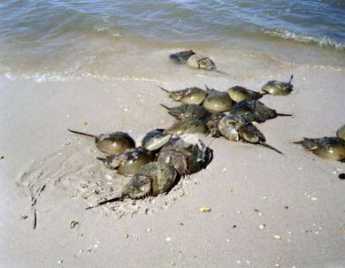
|
| Horseshoe Crabs |
Once a year, a zillion ugly Horseshoe Crabs crawl out of the sea onto the Lewes beaches, and lay a million zillion eggs in the sand. Almost to the moment, a swarm of South American birds swoops out of the skies to eat the eggs. Those birds started flying months earlier from thousands of miles away, but their timing with regard to Delaware crab eggs is perfect, so this evolutionary semi-miracle must have been going on for many centuries.

|
| Cape May |
Now, coming from the other direction, every hour each fall it is possible to see a hawk or two flies south to Cape May, then sort of disappearing in the woods. And then, at some unknown signal, tens of thousands of hawks rise from the bushes and travel together on the thirty-mile passage over the bay and then go on South. Cape May has lots of migratory birds and bird watchers, and it also has Cape May "diamonds", which are funny little stones washed up at the tip of Cape May Point.
In the spring, vast schools of successive species of fish migrate up the Delaware Bay to spawn in the reeds along the shoreline, but as each school encounters the point where the salt water turns fresh, they stop dead. They mill around at this point for several weeks adjusting to the change of water and then go on about their business. While they are there, it is possible for amateurs to catch amazing amounts of fish, if you know the best time, and if you know where the salinity changes. Since heavy or light rainfall can shift the salinity barrier fifty miles, you have to own your own boat if you want to enjoy this phenomenon, since the rental boats are all spoken for months in advance. Fishermen don't like to tell you about such things; patients of mine who literally owed me their lives have refused to say where I might find the fish this year.
Over on the New Jersey side of the bay, oysters like to grow, although something has just about wiped them out in recent decades. There is a town called Bivalve, which is worth a visit just to see the towering piles of oyster shells left over from last century. For miles around, the roads are actually paved with ground-up oyster shells. Up north around Salem, the shad used to run by the millions until the warm water emerging from the Salem (nuclear) power plant attracted them into the intake pipes and action was taken to abate the nuisance. The Salem Country Cub is one of the few places where planked shad can be obtained in season. The system is to split the fish open and nail it to a board, which is then placed in the big open fireplace to cook, and sizzle, and smell just wonderful good. On the other hand, if you want to buy shad in season (March-May) and cook it at home, the place to get it is in Bridgeton.
At the far northern end, at Trenton, the real Delaware River flows into the bay. The area has long since been dredged, but at one time the "falls" at Trenton were notable. Even today, if you travel upriver almost to Lambertville, you will see the river drop over several small ledges. Actually, rapids would probably be a better descriptive term, since Delaware picks up quite a strong current coming down from the Lehigh Valley. In seasons of heavy rainfall, the falls can be completely "drowned".
And down at Philadelphia where we live, the Schuylkill joined Delaware, forming the largest swamp of all at the river junction, a place once famous for its enormous swarms of swans. The Dutch discovered a high point of land at what is now called Gray's Ferry and made it into a trading place for beaver skins from the local Indians. There seems no reason to doubt the report that they took away thirty thousand beaver skins a year from this trading post, now the University of Pennsylvania.
An English sailing vessel was once blown to the East side of Delaware at what would now be Walnut Street in Philadelphia, and it was recorded in the ship's log that it was scraped by overhanging tree limbs. The high ground at that point seemed like a favorable place to situate a city because the water was deep enough for ocean vessels. They had stumbled on one of the relatively few places in the whole bay that was both defensible and navigable, where the game was abundant, and fishing was good. The rest is history.
Forming the State of Delaware
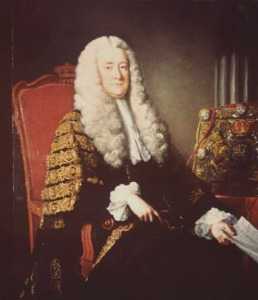
|
| Philip Yorke, Earl of Hardwicke |
When the Duke of York was within hours of being banished, he told his agent Sir John Werden to give the contested strip (now the state of Delaware) to Penn, but save out the town of Newcastle with a twelve-mile strip of land around it. Werden wrote that into the charter with a proviso based on the idea that the fortieth parallel was to the south of Newcastle, when in fact it was fifty miles north of it, and could not possibly conform to the stated boundaries. Both Penn and Baltimore learned the true situation in a year or two, and both attacked the other for dissembling ignorance, each seeking to take advantage of implausible arguments. What in fact they both discovered was that if the dividing line could be pushed a few miles south, Penn would acquire the mouth of the Susquehanna in the Chesapeake Bay, while if it went north a few miles, Maryland would acquire most of Philadelphia. Lord Hardwicke worked out a reasonable compromise which, while ignoring some plain language in the documents, eventually resulted in the Mason-Dixon line which is now reasonably comfortable for everybody, although first subjected to another two decades of wrangle.
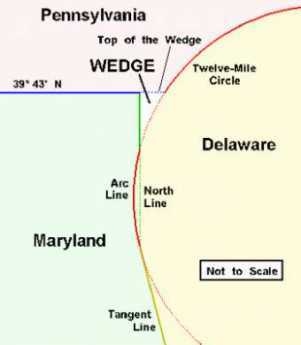
|
| Delaware Wedge |
Even part of the eventual compromise, a semicircular northern border, didn't come out right, resulting in a wedge of no-man's land. Landowners didn't enjoy paying disputed taxes, so they held up the settlement of the wrangle into the Twentieth Century. Eventually, the U.S. Supreme Court cut the wedge into two pieces, giving one piece each to Pennsylvania and Delaware. Meanwhile, disputes continued which had their basis in the way the semi-circular line was plotted out on the land. The surveyors ran 120 straight-line radii outward from the courthouse tower in Newcastle, and then connected the ends. Obviously, that resulted in 120 straight chords instead of a smooth semi-circle, and a couple of bulges had to be accommodated where the circle grazed other straight borders. The semi-circle crossed the Delaware River, so New Jersey helpfully abandoned its portion, only to regret its decision later when toll bridges were constructed, and ship channels deepened.

|
| King Charles I |
Two major societal changes took place between 1632 -- when Charles I granted the proprietorship of Maryland to the first Lord Baltimore -- and 1776 when all American real estate changed its rules. The first change was that the Delaware Bay morphed from a swamp into settlements of people; settlers came into possession. The second evolution was to the current view that if you sell some real estate it is no longer yours; in earlier eras, everything belonged to the king, who could take it away and give it to others as often as he pleased. In legal terms, the last king had the last word. Although acres of parchment were scribbled by lawyers pro and con, these considerations are what make clear how Lord Baltimore could hold the unchallenged legal title for fifty years to everything up to the fortieth parallel, but then have a court take away thousands of square miles. A land which was to become the three lower counties of Pennsylvania was given to William Penn by the Duke of York in 1682, using some flawed documents and only fully enjoyed by Penn's heirs for six years until they morphed into the new State of Delaware. From 1684 to 1769, legal ownership was a matter of continuing dispute. The exasperated Lord Chancellor (Hardwicke) in 1750 declared the case as one "of nature worthy of the judicature of a Roman senate rather than of a single judge".
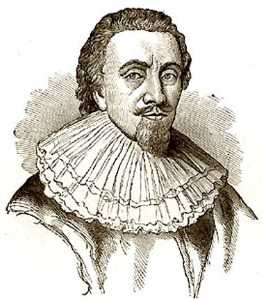
|
| Lord Baltimore |
Lord Baltimore had been given "unsettled" land, occupied only by savages. William Penn's lawyers struggled to prove the Dutch had settled the area before 1632, while Baltimore's lawyers sought to prove that pirates and wandering fur traders don't count, nor do villages of thirty people who were wiped out by the Indians. By the Doctrine of Discovery, taking land from pagans was encouraged, but taking land from Christians required special formalities. Since this Doctrine dates back before there were Protestants, it might have been pertinent to inquire whether the Dutch should be regarded as pagans, as the Spanish surely did when they suppressed Dutch independence in the Eighty Years War, ending in 1648.
Lord Baltimore advertised land along Delaware for sale to settlers while the matter was still under litigation. That was the foulest play said Penn, a weak argument to make if litigation was intentionally pursued for a century.
Maryland favored the Catholic cause, so it seemed plausible for them to want to stall, hoping the Catholic Duke of York would ascend to the throne. Under the new King James II, however, Baltimore seemed unlikely to prevail that the same person, as Duke of York, really didn't own the land he was trying to give to William Penn. So of course, Lord Baltimore claimed he never stalled.
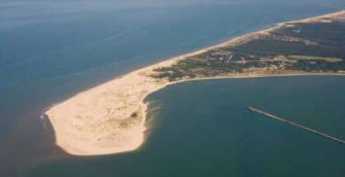
|
| Cape Henlopen |
And by the way, ocean currents moved Cape Henlopen a mile or so southward, but the real boundary problem was that common usage over the centuries confused Cape Henlopen with Fenwick's Island (to which it is usually attached by a thin barrier island), making an implicit difference in the Maryland/Delaware ownership of the corresponding strip of land at the southern border of the State of Delaware, a matter of a hundred or so square miles.
And all of this confusion was merely about the borders of one of the smallest of our fifty states. The political manner in which Delaware became a colony without a charter to the King, and became a state by gradual and mystifying degrees separate from the other counties of Pennsylvania are other complicated stories. Never mind the reasons Delaware remained in the Union during the Civil War, even though it also remained a slave state.
With gratitude to the memory of Dudley Cammett Lunt 1896-1981, whose books are a most readable but scholarly analysis of this complicated history. In particular, The Bounds of Delaware and, for the Mason-Dixon Line, Taylor's Gut in the Delaware State are recommended. The courts rejected arguments that the land was essentially wilderness when Lord Baltimore acquired his patent, and history has been sympathetic to Penn, the winner. The contention was the Dutch owned the land by right of discovery ( a Doctrine applied to land ruled by pagans by Pope Nicholas II in 1454), while the Duke of York later took it from the Dutch by surrender to force of arms -- another legally benign method of acquiring sovereignty. However, Lunt points out that a far more significant issue was the southern border of Pennsylvania in Penn's original grant, which asserted geographical impossibility to replace Maryland's plain and simply defined boundary. History has tended to regard this as understandable error, and subsequent legal quarrels to have been perpetuated by William Penn's greedy heirs. However, Lunt seems to reveal his own opinion of the affair by ending his book with a July 31, 1683 quotation from a letter by William Penn to Colonel Thomas Tailleur:
I, finding this place necessary to my Province and it ye Presence of Ld. Balt. was at Law, civil & common, I endeavoured to get it, & have it, & will keep it if I can.
Boundaries of the Grant of Pennsylvania
Pennyslvania's Boundary: David Rittenhouse, Hero, Lord Baltimore, Villain
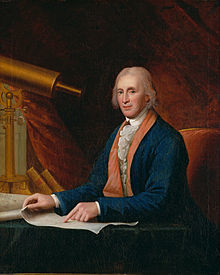
|
| David Rittenhouse |
In the Twenty-first Century, when we know how every American creek and river run, we can see it might have been simple to establish a boundary between the new royal grant to William Penn, and an earlier grant to Lord Baltimore by the then-reigning king's father, Charles I. Essentially: Penn got the Delaware Bay and a lot of wilderness to the west of it. George Calvert, Lord Baltimore, had long held the top half of the Chesapeake Bay and a strip of wilderness to the west of that. Two bays, with two hazy strips of wilderness attached.
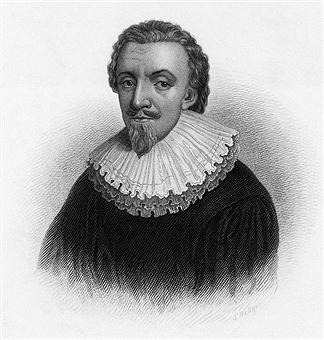
|
| George Calvert, Lord Baltimore |
At what is now Odessa, Delaware, those two bays are only five miles apart; compromise should have settled the issue quickly. Two English gentlemen could have sat down over a pipe and a brew, working something out. However, the English nation was then changing kings, beheading them over matters of religion. A Roman Catholic, Lord Baltimore probably thought an opportunity might emerge from the turmoil if he stalled until matters went his way, since next in line of succession was James, Duke of York, who was a Catholic. But matters fall into the hands of the lawyers when principals of an argument are unable to speak. As we noted elsewhere, in the legal system of the day the last word from the last king was what counted in law courts, accepting any uncertainty about future latest words from future latest kings in order to maintain immediate peace. To lawyers of the time, all this talk about justice, fairness, and geometry was idleness when the nation needed order and stability. So the Calvert family lawyers over the course of eighty years, introduced one specious proposition after another that turned other lawyers purple with rage. Penn's lawyer, Benjamin Chew, beat them at this game, and his mansions in Delaware and Germantown attest to the value attached to this achievement. In other circumstances, posturing might have led to war, as it did in similar disputes with Connecticut. Penn probably knew better, but it takes two to compromise.
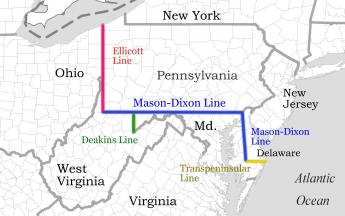
|
| Mason-Dixon Line |
It must be admitted that honest confusion was possible. Sometimes, a line of latitude was a line in the sense Euclid intended: all length and no width. At other times, lawyers and kings were talking about "parallels" as if they were strips, roughly sixty miles wide. If a sixty-mile strip was intended, it was important for a grant to specify whether it extended to the southern edge of the strip, or to the northern edge. But in fact, the state of science in the Seventeenth Century contained uncertainty about both where the strips were, and how wide. And if the grant's language didn't even make it clear whether the parties were talking about strips or width-less lines, eighty years could be a comparatively short time for a court to decide the case. To be fair to Lord Baltimore, many people at the time didn't think these matters were capable of fair solution, so the traditional way of dealing with land disputes was either by force or by craftiness.
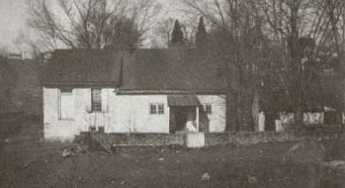
|
| David Rittenhouse Birth Place |
In William Penn the folks from Maryland were, unfortunately, dealing with a friend of the King, who had one of the most brilliant mathematicians in Western civilization as his adviser. David Rittenhouse may have been born in that little farmhouse you can still visit on the Wissahickon Creek, and made his living as a clockmaker, but his native talents in mathematics, astronomy surveying, and instrument construction were so deep and so varied that later biographers are reduced to describing him merely as a "scientist" and letting it go at that. If you want to sample his talents, spend an hour or two learning what a vernier is, and then see if you could apply that insight, as he did, to a compass. So, as it turned out, Rittenhouse was able to describe a twelve-mile circle around New Castle, Delaware, construct a tangent that divides the Delmarva's Peninsula in half, and match it up with an east-west line we now call the Mason Dixon Line. When they finally got around to laying these lines on the ground, Mason and Dixon cut a twenty-four-foot swath through the forest, using astronomical adjustments every night, and laying carved marker stones every fifth of a mile for hundreds of miles. The variation from the line devised by Rittenhouse was at most a fifth of a mile off the mark; the intersection with the north-south line between Maryland and Delaware was less successful. The survey by Mason and Dixon was not quite completed to the Ohio line because the Indians, curious at first, eventually became wild with suspicion at such behavior, particularly the part about going out and aiming cannons at the sky every night. It seems likely that George Calvert, Lord Baltimore, had no more confidence in this madness than the Indians did.
So, the next time you take the train from Philadelphia to Washington DC, reflect that strict reading of the words in the land grants did admit the possibility that your whole trip could either have been within the State of Maryland, or else in the Commonwealth of Pennsylvania, depending on whether lawyers, or scientists, had triumphed in this dispute. Since the Mason Dixon Line later divided not merely two states, but two violently opposed cultures, Rittenhouse must stand out in the history of one of those people who were so smart that most people couldn't understand how smart he was.
Pirate Lair

|
| Jolly Roger Flag |
Delaware takes a ninety-degree turn right at about the place where the Salem nuclear cooling towers are visible on the Jersey shore, and great quantities of silt have piled up in the river there, making marshes and swamps. There is a rumor that Captain Kidd tied up among these marshy islands, and much better evidence that Blackbeard the Pirate used the Delaware marshes as a hideout. Since a high-speed highway, with limited access, now rushes visitors to the slot machines of Dover and the beaches of Lewes, no one much notices that this area hasn't changed much from what it probably looked like three hundred years ago.
But if you take the old road, Delaware Route 9, you wander through the backcountry and are only likely to meet duck hunters. At one point, with a lake to one side and the river on the other, a watchtower has been erected for bird watchers and the like. It's very beautiful there, and quiet.
So one day I drove up, parked my car at the base of the tower, and climbed a hundred steps to the top. Blackbeard was not in evidence, but it was easy to see how he might feel pretty secluded in the coves and behind the trees. There were lots and lots of birds, interesting enough but mostly unidentifiable by me. Like most big-city lovers of the environment, I mostly classify birds as little brown jobs (LBJ) and big black buggers (BBB). And then a car drove up, with some chattering teenagers.

|
| Copperhead |
From a hundred feet up, it was hard to tell what they were saying, and it probably didn't matter much. Until suddenly one of the girls screeched out, "Oh look! There's a big snake under that man's car! "
One of the boys in the car shouted out, "That's a copperhead snake! I've never seen one so big!"
And so, they roared off into the distance, leaving the marshy paradise to me and the snake. What do I do now?
I waited, hoping the snake would go away. But it started to get dark, and now it was even more unattractive to chase around with snakes. So, creeping to the bottom of the stairs, I made a dash for the car door, jumped in, and slammed it tight.
As I drove away, I could not see any snake on the ground under the place where I had parked. To this day, I don't know if there really was a snake there or not.
Delaware Declares Independence ... From Pennsylvania
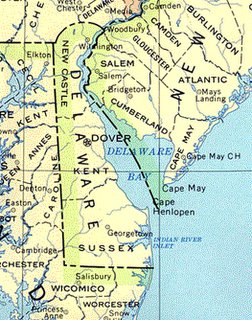
|
| Delaware Map |
To bewilder your friends from the State of Delaware, just ask them when and why Delaware broke off from Pennsylvania; chances are they haven't the foggiest answer. But they will recognize it is a legitimate question. Everyone does know that Delaware was once owned by William Penn and was part of Pennsylvania. It was generally referred to as the three Lower Counties. But what happened then doesn't seem to be taught very effectively in the Delaware schools, and not much is written about it.
Not much is written because not much happened. No revolutions, bombings, hangings or even acrimonious debate; just think how much Serbia, Russia, China, Sudan and a lot of other countries have to learn about self-determination, from Delaware.
The history of Delaware up to 1674 was of Dutch, Swedish and even some Finnish settlement and arguments; doesn't count. The Duke of York (later James II) owned it and seems brief to have toyed with combining it with New York; that's how Delaware happens once to have been called the South River, and the Hudson the North River. But William Penn acquired it in 1682, mostly with the motive of having unchallenged access to the ocean from Pennsylvania. Apparently, the people who lived away from the river felt more kinship with Maryland, and expressed unwillingness to be linked with some religious experiment in Philadelphia, especially if they had to travel there to settle their affairs. There is not much Catholicism in Delaware at present, but that seems to have been part of the uneasiness in 1701. So Penn granted them quasi-autonomy and their own separate assembly, which resulted in a peaceful enough arrangement until the American Revolution. Penn got all he wanted, which was to sell off the land and maintain a clear river passage, and by the time of the Revolution, his descendants had lost all control of things. The control of Pennsylvania over its three lower counties had never been terribly firm, and during the eight-year Revolutionary chaos, it sort of drifted away. When its votes were needed for the Declaration of Independence and later for the Constitution, it was expedient to recognize Delaware's claims.
That's perhaps all there is to this vague story of statehood building, except for one nagging doubt. Delaware was a plantation state and a slave state. It's sided with the North during the Civil War, but it remained a slave state. It voted against Lincoln's Emancipation overtures, and refused to ratify the Thirteenth, Fourteenth and Fifteenth Amendments until 1901. Until the Lewes-Cape May ferries got busy with Garden State Parkway traffic, lower Delaware's population was almost exclusively either African-American or many-generation English descendants. The hospitals had white-only and black-only restrooms until the Second World War. Nothing better illustrates that the Civil War was primarily fought to defend the Union, rather than to eliminate slavery, than the tangled local history of the border states, of which Delaware was definitely one.
And so, you have to wonder. Is it possible that the residents of the Lower Counties in 1776, especially in the southern portion where John Dickinson had a plantation, could recognize that the Quakers of Pennsylvania were relentlessly moving in a direction which surely would eventually conflict with the slave system? Maybe, looking ahead, the chaos of Revolutionary times provided a plausible moment to make a clean separation. These are awkward questions to ask, perhaps best passed by, in silence.
Delaware's Court of Chancery
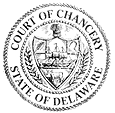 |
| Chancery |
Georgetown, Delaware is a pretty small town, but it's the county seat so it has a courthouse on the town square, with little roads running off in several directions. The courthouse is surprisingly large and imposing, even more, surprising when you wander through cornfields for miles before you suddenly come upon it. The county seat of most counties has a few stores and amenities, but on one occasion I hunted for a barbershop and couldn't find one in Georgetown. This little town square is just about the last place you would expect to run into Sidney Pottier and all the top executives of Walt Disney. But they were there, all right, because this was where the Delaware Court of Chancery meets; the high and mighty of Hollywood's most exalted firm were having a public squabble.
Only a few states still have a court of Chancery, but little Delaware still has a lot of features resembling the original thirteen colonies in colonial times. The state abolished the whipping post only a few decades ago, but they still have a chancellor. The Chancellor is the state's highest legal officer, and four other judges now need to share his workload, which was almost completely within his sole discretion seventy-five years ago. In fact, the Chancellor usually heard arguments in his own chambers, later writing out his decisions in longhand. The Court of Chancery does not use juries.
Going back to Roman times, the Chancellor was the highest office under the Emperor, and in England, the Lord Chancellor is still the head of the bar in a meaningful way. Sir Francis Bacon was the most distinguished British Chancellor and gave the present shape to a great deal of the present legal system. A court of Chancery is concerned with the legal concept of equity, which is a sense of fairness concerning undeniable problems which do not exactly fit any particular law. The Chancellor is the "Keeper of the King's conscience" concerning obvious wrongs that have no readily obvious remedy. You better be pretty careful who gets appointed to a position like that, with no rules to follow, no supervisor, no jury, dealing with mysterious issues that have no acknowledged solution.
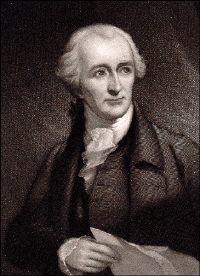 |
| George Read |
Delaware's Court of Chancery evolved in steps, with several changes of the state Constitution over a span of two hundred years. As you might guess, a few powerful chancellors shaped the evolution of the job. Going way back to 1792, Delaware changed its Supreme Court from the design of its Constitution, and George Read was the new Chief Justice. However, it was all a little embarrassing for William Killen, who had been the Chief Justice, getting a little old. Read refused to have Killen dumped, and in this he was joined by John Dickinson, who had been Killen's law clerk. So Killen was made Chancellor, and a court of Chancery was invented to keep him busy.
Under a new 1831 Constitution, the formation of corporations required individual enabling acts by the Legislature and limited their existence to twenty years. However, the 1897 Constitution relaxed those requirements and permitted entities to incorporate under a general corporation law and allowed them to be perpetual. By this time, other states were distributing equity cases to the county level, but Delaware was too small to justify more than a single state-wide Court. That court was attractive to corporations because it could become specialized in corporate matters, but retained a pleasing number of equity cases among common citizens, thus retaining a folksy point of view. In unique situations or those without a significant history of public debate, it was thought especially desirable to strive for unchallenged acceptance of the court's decision.
But other states thought they could see what Delaware was up to. In 1899 the American Law Review contained the view that states were having a race to the bottom, and Delaware was "a little community of truck farmers and clam-diggers . . . determined to get her little, tiny, sweet, round baby hand into the grab-bag of sweet things before it is too late." However, that may be, corporations stampeded to incorporate in the State of Delaware, and the equity of their affairs was decided by the Chancellor of that state. In one seventeen year period of time, the U.S. Supreme Court reversed the decision of the Chancellor only once.
 Chancery's jurisdiction was complementary to that of the courts of common law. It sought to do justice in cases for which there was no adequate remedy at common law.  |
| A. H. Manchester Modern Legal History of England and Wales, 1750-1950 (1980) |
Some legal scholar will have to tell us if it is so, but the direction and moral tone of America's largest industries has apparently been shaped by a small fraternity or perhaps priesthood of tightly related legal families, grimly devoted to their lonely task in rural isolation. The great mover and shaker of the Chancery was Josiah O. Wolcott (1921-1938), the son and father of a three-generation family domination of the court. Most of the other members of the court have very familiar Delaware names, although that is admittedly a common situation in Delaware, especially south of the canal. The peninsula has always been fairly isolated; there are people still alive who can remember when the first highway was built, opening up the region to outsiders. Read the following Chancelleries quotation for a sense of the underlying attitude:
"The majority thus have the power in their hands to impose their will upon the minority in a matter of very vital concern to them. That the source of this power is found in a statute, supplies no reason for clothing it with a superior sanctity, or vesting it with the attributes of tyranny. When the power is sought to be used, therefore, it is competent for anyone who conceives himself aggrieved thereby to invoke the processes of a court of equity for protection against its oppressive exercise. When examined by such a court, if it should appear that the power is used in such a way that it violates any of those fundamental principles which it is the special province of equity to assert and protect, its restraining processes will unhesitatingly issue."
That is a very reassuring viewpoint only when it issues from a person of totally unquestioned integrity, a member of a family that has lived and died in the service of the highest principles of equity and fairness. But to recent graduates of business administration courses in far-off urban centers of greed and striving, it surely sounds quaint and sappy. And many of that sort have found themselves pleading in Georgetown. Just let one of them a bribe, muscle, or sneak into the Chancellor's chair someday, and the country is in peril.
Tony Junker: Tunnell's Boys

|
| Henry Hudson |
When you take the ferry across the mouth of Delaware Bay from Lewes to Cape May, you are out of sight of land for half an hour. But the Army Corps of Engineers have thoroughly dredged it out. By contrast, when Henry Hudson first discovered the river while searching for a Northwest passage to the Indies, it was so full of snags and shoals that he just gave up and sailed on to what is now New York harbor. So, for centuries the river pilots were an essential part of ocean commerce to Philadelphia. As you might well imagine, the earliest pilots were members of local Indian tribes. Eventually, a proud colony of professional pilots grew up at Lewes, Delaware. Since radio communication is a comparatively recent development in this ancient trade, they had to devise ways for an incoming ship to select a pilot, and establish rules to be enforced by the Port Wardens about how to go about it.
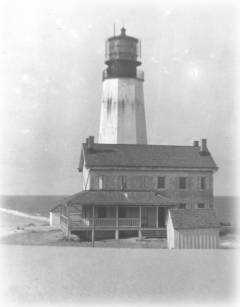
|
In the mid-Eighteenth Century, the system was to hang a black ball from the Cape Henlopen lighthouse whenever a ship was sighted. Little companies of ten or fifteen pilots would then jump into very fast schooners designed for the purpose, and race to be first out to the ladder hanging from the incoming ship's side. The rule was, the first to arrive and present his certificate got the job. Tony Junker, an actively practicing Philadelphia architect has immersed himself in tales and adventures among the pilots, and Tunnell's Boys is an exciting new novel about this dangerous, wet and uncomfortable, profession.
Elizabethan Accents in Philadelphia

|
| William Shakespeare |
The following is nearly verbatim recounting of a conversation which took place in Philadelphia, between two Philadelphians, in the year 2006, Elizabeth II reigning. The scene is the dressing room for the basement exercise area of a private club. There are about forty stalls for members to hang up their clothes before going into the gym. Although clothes are usually seen hanging in no more than three or four stalls, on this particular day there was only one empty stall, at the far end of the long corridor.
FIRST STRANGER: Well, we certainly have a lot of athletes in the club, today.
SECOND STRANGER: You're very generous with that description of our members.
FIRST STRANGER: Perhaps I ought to call them athlete-wannabees.
SECOND STRANGER: Yes, that's apt.
(Exeunt)
Shakespeare would have expressed it a little better, but anyone can recognize in this little exchange, the elements of those short interlude scenes in Shakespearean plays. The bit players create brief background while the stagehands shift scenery between major acts. Nobody actually has an Elizabethan accent these days, but in Quaker and Upper-Crust Philadelphia circles, the Elizabethan manner of speaking pops out at odd moments, as a coded way of asking strangers, "Are you a native Philadelphian? You sort of look like one." If the stranger doesn't seem to grasp the idea, well, let it pass.
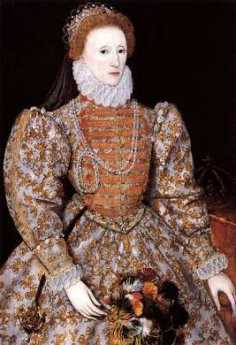
|
| Elizabeth I |
In the more remote sections of the Delmarva peninsula, it is claimed the natives often do speak in a pure Elizabethan accent. Somehow I am dubious of that, having listened for it over sixty years of travel in those regions. Rural Delaware talks with a softened version of a Southern accent, even softer than you hear in Tidewater Virginia. It's hard to believe that Marlowe and Shakespeare talked like that. But go into a roadside coffee shop and listen to the truck drivers joshing the waitress; it's not an accent but an Elizabethan manner of address that's recognizable. They self-consciously stop talking that way when obvious strangers come into the shop.
Because of Dr. Samuel Johnson's dictionary, Shakespearean adjectives pepper English speech in all regions of the world. Johnson was a theater critic in his early days, so when he needed familiar quotations to illustrate the words in his dictionary, he drew heavily from Shakespeare. William Shakespeare's tendency to invent likely vocabulary was thus enshrined by Johnson's dictionary as
Georgetown Oyster Eat: Separate but Equal

|
| Oyster Knife |
It's a source of some regret never to have attended the Georgetown Oyster Eat. It occurs in the middle of February when the days are dark and short, and the weather is uncertain for driving.
Local citizens of Sussex County, Delaware, report no one alive remembers when or how the custom began. In the nature of such things, a certain amount of historical inaccuracy is thus to be expected. It certainly did start out as an all-male event, taking place in the firehouse. One inflexible requirement is that a participant must bring his own oyster knife, which is a very heavy chunk of iron with a short blade attached, sort of like a screwdriver. The ones I have seen are all one piece of iron, suggesting they have been hammered out in a blacksmith shop. The flattened-out blade serves as an eating utensil, as well as a wedge to pry open the oyster shell. The oysters are eaten raw and whole, often with some sort of condiment, like horseradish sauce. Some eaters favor a whole lot of ground pepper, and various other ancient remedies are said to make an appearance. The main beverage is beer, lots of beer.
Beyond that, not much is known or divulged to the public, although a party attended by nearly a thousand tipsy people can't keep very many secrets. Before the party, the windows of the firehouse are covered with brown wrapping paper, sealed with tape. Kegs of oysters and kegs of beer are rolled into the firehouse before other things get rolling, and a lot of loud noises and laughter emerge almost all night. The sponsors claim to bring a thousand bushels of oysters to each party, although it is hard to imagine very many people eating their quota of a bushel apiece. The per-person beer consumption is a statistic kept confidential. The ladies of the neighborhood report numerous husbands eventually returning home, with their glasses broken, and suspicious red bruises on their faces. Aside from that, nobody knows nothing'.
About ten or fifteen years ago, feminism reached the Delmarva Peninsula, and the ladies started their own brawl. Renting the Grange Hall and brown-papering the windows, they make a lot of noise come out all night. Because of some sort of oyster virus, oysters are not nearly so plentiful any more. There's a more elaborate accusation that excessive fertilizer on the farm fields runs off and stimulates a bloom of algae, which depletes the oxygen of the river and kills a lot more than oysters. Anyway, the oysters are in short supply. If the local firehouse custom dies out, it won't be from lack of enthusiasm, however.
Caesar Rodney Rides Through the Rain
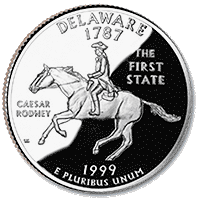
|
| Caesar Rodney |
If you have a quarter minted in 1999, you can see a depiction of Caesar Rodney riding through the rain, mud and heat, all night, to cast his July 2 vote for independence at the 1776 Continental Congress. There are no known painted portraits of Rodney, probably because his face was badly mutilated by cancer which ultimately killed him.
On July 1, Thomas McKean and George Read had split Delaware's votes in a tie, and McKean had urgently sent word to Rodney, the absent third vote, that he must come to Philadelphia quickly. Rodney was suffering from cancer. It may thus have been Thomas McKean's idea to invoke the concepts of the Treaty of Westphalia to escape hanging for armed rebellion, but Ben Franklin seems more likely. Once an idea like that gets started in a gathering, it quickly becomes everyone's idea. But Franklin was the only one to stampede a group and take no credit for doing so.

|
| Rodney |
Schoolchildren in Delaware can be forgiven for asking why Rodney wasn't in Philadelphia for the vote without being sent for. And we don't really know. Rodney certainly had plenty of other things competing for his attention, like being a Supreme Court Justice, the Speaker of the Delaware Assembly and the de facto Governor of the State, as well as being a Brigadier General in the Militia (he later was made Major General in charge of the garrison at Trenton). One has to suspect, however, that he had not expected George Read to vote against independence. Read, after all, had married the widowed sister of George Ross, who did sign the Declaration.
Asthma, a notoriously intermittent condition, may have been a worse impediment to Caesar Rodney's ride than his cancer. Although he was badly disfigured, cancer did not kill him until 1784. The prospect of riding eighty miles in the rain with asthma may well have been the reason Rodney held off until he was absolutely certain his vote was needed. The esteem and affection that Delaware holds for this farmer from Dover can be gauged by the fact that he remained the elected speaker until the day he died, and during his last three months, the legislature held its meetings in his house so he could be present.
John Dickinson, Quaker Hamlet
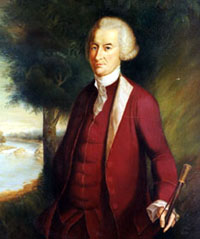
|
| John Dickinson |
John Dickinson (1732-1808) would probably be better known if his abilities were less complex and numerous. It would have been particularly helpful if he had consistently remained on only one side of the important issues of his day. Born in a Quaker family and buried in a Quaker graveyard, he was for years a notable Episcopalian and soldier. He outwitted John Penn, the Pennsylvania Proprietor who was trying to keep Pennsylvania from sending representatives to the Continental Congress, by having the Pennsylvania representatives hold a meeting in the same small room of Carpenters Hall at the same time as the Congress. But he ultimately refused to sign the Declaration of Independence. Although he was the main author of the Articles of Confederation, the Constitution which replaced it would not have been ratified without his idea of a bicameral Congress. Although he was Governor of Pennsylvania, he was also Governor of Delaware, has been the central figure in the separation of the two states. In fact, for fifteen years he was a member of the Legislature of both states. Dickinson seems in retrospect to have been on every side of every argument, but he was immensely respected in his time.
Two events seem to have been central in the organization of his life. The first was his education as a lawyer. At that time and for a century afterward, lawyers were trained by apprenticeship. Dickinson, however, studied in London at the Inns of Court for four years and was by far the most distinguished lawyer in North America for the rest of his life. Furthermore, he absorbed the principles of the Magna Carta and the approaches of Francis Bacon so thoroughly that he never quite got over his pride in his English heritage. Throughout his leadership of the colonial rebellion, he acted as a better Englishman than the English themselves. His demand was for American representation in the British Parliament, not independence from England. It would not be hard to imagine Dickinson standing before a firing squad, gritting the words of St. Paul, Civis Romani Sum.
His other pivotal experience was the Battle of Brandywine. Dickinson had been the organizer or chairman of the two main Pennsylvania military organizations, the Pennsylvania Committee of Safety and Defense, and the so-called Associators (today's 111th Infantry, the first battalion of troops in Philadelphia). Both of these particular names were a characteristic gesture to conciliating pacifist Quaker feelings. Nevertheless, when Dickinson refused to sign the Declaration, he did temporarily become so unpopular he resigned his military commands. A few months later, when General Howe landed at Elkton at the narrow neck of the Delmarva peninsula, Dickinson enlisted as a common soldier to defend the southern perimeter of the defense line Washington had hastily thrown up to defend Philadelphia. Shortly afterward, Dickinson's friend and neighbor Caesar Rodney made him a Brigadier General in charge of the garrison around Elizabeth New Jersey, but the Battle of Brandywine taught an important lesson. Little states like Delaware and Maryland could not possibly defend themselves witho
Aftermath: Who Won, the States or the Federal?
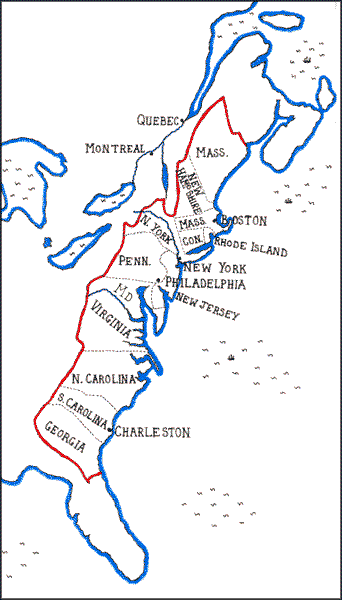
|
| Thirteen Sovereign States |
In the case of the American Constitution, the initial problem was to induce thirteen sovereign states to surrender their hard-won independence to a voluntary union, without excessive discord. Once the summary document was ratified by the states, designing a host of transition steps became the foremost next problem. The dominant need at that moment was to prevent a victory massacre. The new Union must not humble once-sovereign states into becoming mere minorities, as Montesquieu had predicted was the fate of Republics which grew too large. Nor must the states regret and then revoke their union as Madison feared after he had been forced to agree to so many compromises. As history unfolded, America soon endured several decades of romantic near-anarchy, followed by a Civil War, two World Wars, many economic and monetary upheavals, and eventually the unknown perils of globalization. When we finally looked around, we found our Constitution had survived two centuries, while everyone else's Republic lasted less than a decade. Some of its many flaws were anticipated by wise debate, others were only corrected when they started to cause trouble. Still, many tolerable flaws were never corrected.
 Great innovations command attention to their theory, but final judgments rest on the outcome. 
|
| . |
Benjamin Franklin advised we leave some of the details to later generations, but one might think there are permissible limits to vagueness. The Constitution says very little about the Presidency and the Judicial Branch, nothing at all about the Federal Reserve, or the bureaucracy which has since grown to astounding size in all three branches. Political parties, gerrymandering, and immigration. Of course, the Constitution also says nothing about health care or computers or the environment; perhaps it shouldn't. Or perhaps an unmentioned difficult topic is better than a misguided one. Gouverneur Morris, who actually edited the language of the Constitution, denounced it utterly during the War of 1812 and probably was already feeling uncomfortable when he refused to participate in The Federalist Papers . Madison's two best friends, John Randolph, and George Mason, attended the Convention but refused to sign its conclusions, as Patrick Henry and Thomas Jefferson almost certainly would also have done. On the other hand, Alexander Hamilton and Robert Morris came to the Convention preferring a King to a President, but in time became enthusiasts for a republic. Just where John Dickinson stood, is very hard to say. Those who wrote the Constitution often showed less veneration for its theory, than subsequent generations have expressed for its results. Understanding very little of why the Constitution works, modern Americans are content that it does so, and are fiercely reluctant about changes. The European Union is now similarly inflexible about the Peace of Westphalia (1648), suggesting that innovative Constitutions may merely amount to courageous anticipations of radically changed circumstances.
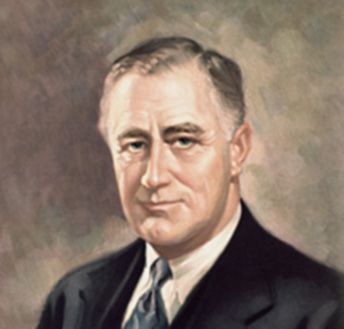
|
| President Franklin Roosevelt |
One cornerstone of the Constitution illustrates the main point. After agreeing on the separation of powers, the Convention further agreed that each separated branch must be able to defend itself. In the case of the states, their power must be carefully reduced, then someone must recognize when to stop. If the states did it themselves, it would be ideal. Therefore, after removing a few powers for exclusive use by the national government, the distinctive features of neighboring states were left to competition between them. More distant states, acting in Congress but motivated to avoid decisions which might end up cramping their own style, could set the limits. The delicate balance of separated powers was severely upset in 1937 by President Franklin Roosevelt, whose Court-packing proposal was a power play to transfer control of commerce from the states to the Executive Branch. In spite of his winning a landslide electoral victory a few months earlier, Roosevelt was humiliated and severely rebuked by the overwhelming refusal of Congress to support him in this judicial matter. The proposal to permit him to add more U.S. Supreme Court justices, one by one until he achieved a majority, was never heard again.
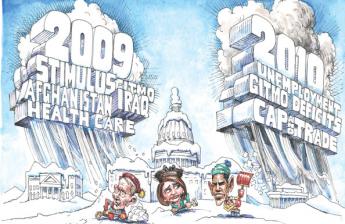
|
| Taxes Disproportionately |
Although some of the same issues were raised by the Obama Presidency seventy years later, other more serious issues about the regulation of interstate commerce have been slowly growing for over a century. Enforcement of rough uniformity between the states rests on the ability of citizens to move their state of residence. If a state raises its taxes disproportionately or changes its regulation to the dissatisfaction of its residents, the affected residents head toward a more benign state. However, this threat was established in a day when it required a citizen to feel so aggrieved, he might angrily sell his farm and move his family in wagons to a distant region. People who felt as strongly as that was usually motivated by feelings of religious persecution since otherwise waiting a year or two for a new election might provide a more practical remedy. However, spanning the nation by railroads in the 19th Century was followed by trucks and autos in the 20th, and then the jet airplane. While moving residence to a different state is still not a trivial decision, it is now far more easily accomplished than in the day of James Madison. A large proportion of the American population can change states in less than an hour if they must, in spite of a myriad of entanglements like driver's licenses, school enrollments, and employment contracts. The upshot of this reduction in the transportation penalty is to diminish the power of states to tax and regulate as they please. States rights are weaker since the states have less popular mandate to resist federal control. It only remains for some state grievance to become great enough to test the present power balance; we will then be able to see how far we have come.

|
| High Gasoline Taxes of Europe |
Since it was primarily the automobile which challenged states rights and states powers, it is natural to suppose some state politicians have already pondered what to do about the auto. The extraordinarily high gasoline taxes of Europe have been explained away for a century as an effort to reduce state expenditures for highways. But they might easily be motivated by a wish to retard invading armies or to restrain import imbalances without rude diplomatic conversations. But they also might, might possibly, respond to legislative hostility to the automobile, with its unwelcome threat to hanging on to local populations, banking reserves, and political power.
It helps to remember the British colonies of North America were once a maritime coastal settlement. The thirteen original states had only recently been coastal provinces, well aware of obstructions to trade which nations impose on each other. Consequently, they could readily design effective restraints to mercantilism within the new Union. Two centuries later, repeated interstate quarrels provided fresh viewpoints on old international problems. As globalization currently becomes the central revolution in trade affairs of a changing world, America is no beginner in managing the intrigues of international commerce. Or to conciliating nation states, formerly well served by nation-state principles of the Treaty of Westphalia, but this makes them all the more reluctant to give some of them up.
A Pennsylvania Farmer in Delaware
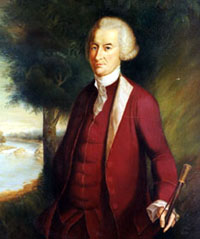
|
| John Dickinson |
It is difficult to have a coherent view of the mind of John Dickinson. Seriously offended by the Townshend Acts, he rightly perceived them to be the work of a few malignant personalities in British high places who would mostly soon be replaced. Later on, he refused to be troubled by the inconsequential Tea Act, which he appraised as a face-saving gesture of reconciliation, but more recent historical information demonstrates was more likely aimed at avoiding an unrelated vote of no-confidence in Parliament. Unfortunately, Dickinson was too remote from these events and additionally could not comprehend reckless hotheads among his own neighbors. Reckless hotheads in turn seldom comprehend the measured meekness of Quakers. In any event, although Dickinson played a major role in the Declaration of Independence, he refused to sign it when the time came, evidently sensing an opportunity to separate the three lower counties from Pennsylvania and its Proprietors. A few months later when the British actually invaded the new State of Delaware on the way to capturing Philadelphia by way of Chesapeake Bay, Dickinson enlisted as a common soldier and fought at the Battle of Brandywine. Obviously, he was seriously conflicted.
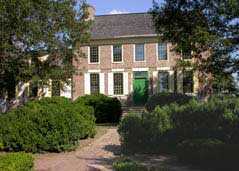
|
| John Dickinson's Farmhouse |
Dickinson had become internationally famous for twelve letters he had meant to publish anonymously. The Letters From a Pennsylvania Farmer were written about 1768 out of resistance to the Townshend Acts. Because the three counties which were to become the State of Delaware were then still part of Pennsylvania, many school children have become understandably confused about the actual location of the man who became governor of both states, simultaneously.
The causes of the separation of the two colonies are still a little vague. Delaware schoolchildren are taught the two states separated, but often report they didn't retain much information about why it happened. The Dutch and Swedes who originally settled southern Delaware were not sympathetic with Quaker rule, which could be seen as a reaction to their living here for generations as Dutchmen before William Penn arrived, but then saw the colony sold out from under them. As a further conjecture, there might have been friction with the Quakers over slavery, similar to the hostility of other Dutch settlers in northern New Jersey when William Penn purchased that area. This pro-slavery attitude resurfaced in both areas during the Civil War. One alternative theory which has considerable currency in Delaware is local dissension about Quaker pacifism during the Revolutionary War. On a recent visit to Dickinson's home outside Dover, a school teacher was overheard to instruct his flock that the Dutch Delawarians wanted to fight the British King, but the Quakers wouldn't give them guns. "We value peace above our own safety," was the unsatisfying response they received from the Pennsylvania Assembly. But that line of reasoning bumps up against Dickinson's role in local affairs, his ambiguity over the Declaration, and his vacillation in warfare. One would suppose the simultaneous Governor of both states would play a major role in the separation of the two.
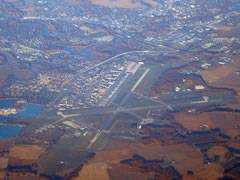
|
| over Air Force Base |
Dickinson's plantation, quite elaborately restored and displayed, is tucked behind the Dover Air Force Base. Perhaps all that aircraft noise will discourage sub-development in the area of Dickinson's plantation and the rural atmosphere may persist for years. At the time of the Cuban missile crisis, your correspondent happened to be driving past, observing the sky filled with bombers, just circling and circling until the diplomats settled matters. Since eight-engine bombers are seldom seen around Dover, it has always been my presumption that they came from elsewhere to be refueled at Dover; but that's just a presumption. One of the pilots later told me he was carrying nuclear "eggs" and was completely prepared to take a long trip to deliver them.
To get back to Dickinson's wavering about the Declaration, maybe there was a good reason to waver. Joseph J. Ellis (in His Excellency, George Washington) relates that after the devastating British defeat at the Battle of Saratoga, Lord North made an offer to settle the war on American terms. In a proposal patterned after the concepts of the separatists in Ireland, America could have its own parliament as long as it maintained trade relationships with England. As an opening offer, that comes pretty close to what the colonists had been demanding. Governor Morris was active in disdaining this offer, although it is unclear whether he was acting alone or as the agent of others. The offer came too late to be accepted, but it might have shortened the war by six years, and we might now have a picture of the Queen on our postage stamps.
REFERENCES
| His Excellency: George Washington: Joseph J. Ellis: ISBN-13: 978-1400032532 | Amazon |
| Letters From A Farmer In Pennsylvania To The Inhabitants Of The British Colonies (1903): John Dickinson: ISBN-13: 978-1163969533 | Amazon |
Georgetown Returns Day
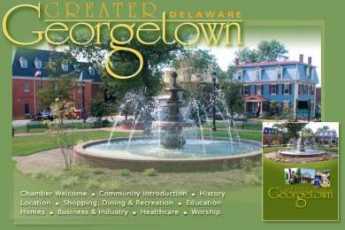
|
| Georgetown |
Early in November, two days after each election, Georgetown Delaware puts on a festival called Returns Day. About two hundred years ago, there was a law that all ballots had to be cast in person at the courthouse in the county seat (Lewes, at that time), and it took two days to count the votes. Everyone, candidates included, would hang around at the courthouse to learn who had won. After a few elections, except in wartime when the ceremony was temporarily skipped, the popular tradition has continued even though of course the election results are known much earlier. Although the function of revealing election results has yielded to the news media, the ceremony has assumed importance for its own sake. Unless it rains pretty hard, the parade lasts three hours, with ten or twelve marching bands, and local amateurs struggling with bagpipes. The candidates, winner, and loser, ride gamely around the square in horse-drawn carriages. You can imagine what would happen to the political future of any candidate who declined to participate in what is now a mandatory public entertainment.
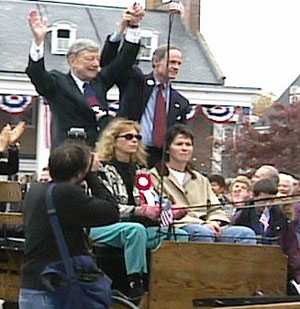
|
| U.S. Senator from Delaware |
Two features of this festival are especially notable. There is a hatchet-throwing contest, trying to get the flying hatchet to catch one corner in a post. It's not an easy thing to do. And then there is hatchet-burying, which is said to date back to the Nanticoke Indians. The traditional hatchet is brought from Lewes, as is the sand. This is all said to be the origin of the folk-saying about burying the hatchet, and it's really very heart-warming to believe the election is only an election, and the competition is over. It's probably not entirely true, of course, but it symbolizes what the public wants to believe is true. And what the public is telling politicians -- had soon better become true, again.
Odessa, Delaware
Delaware is a pretty small state to be divided into two civilizations, and in fact, it seems safe to predict that division will soon become meaningless. New Castle County and Wilmington are up north in DuPont country, with more Ph.D.'s than anywhere else in America, chateaux in the suburbs, plenty of Porsche's and other elements of the finer life. The other two counties, "South of the Canal," are rural, marshy, or beach front. Wal-Mart country. Aside from a distinct difference in the weather patterns, all of this is destined to change, and soon. A limited-access toll road, probably mostly intended to carry people to the slot machines of Dover Downs, makes it breezily simple to go from one end of the state to the other in an hour. A ferry from Cape May to Cape Henlopen makes sailing across the mouth of the bay a shorter simpler way to go from the urban areas of New York to and from Washington, Norfolk and points South. And changes in the tax laws make Delaware a great place to avoid sales taxes, estate taxes, business taxes, usury laws and lots of other things. That brings in businesses, and they, in turn, will bring in a swarm of home builders. It looks very likely Delaware will go the way of Luxembourg, urbanized from border to border.
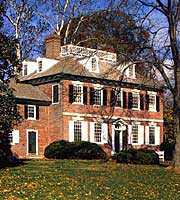
|
|
The Corbit-Sharp House Built in 1774 Located in Odessa, Delaware. |
Little Odessa (population 280) sits right at the pivotal point in this transformation. Here is the very narrowest point of the peninsula between Delaware and the Chesapeake bays. In the Seventeenth Century, there was only a five-mile portage from the head of one creek to the head of the other; the town there was called Cantwell's Bridge. Just why the two Delaware-Chesapeake canals were built a few miles further North is an engineering question, but they tended to shelter Cantwell's Bridge from Northern influences. The neck was so narrow, however, that the road couldn't avoid the town, and for a century it was a pleasure to find a little Colonial town, a little Williamsburg so to speak, popping up among the fields of clover bordering a drive to Dover. A few miles to the West, a very fine boy's boarding school adds to the tone of the place, and it's only a short 9-mile commute to the University of Delaware. The finest 18th Century country house, the Corbit-Sharp House sets the tone for the area, and Christmas season in Odessa is quite memorable. Rodney Sharp was the son of the local school teacher who acquired financial substance, private jet airplanes and all that, on the other side of the canal, and then restored his old home the Corbit house into the Corbit Mansion, bringing the whole farm village up to an elegant level. A visit to Odessa at Christmas, touring the open houses and visiting the festivities, is well worth the trip.
You have to hold your breath to see what is going to happen to real estate in the area. The toll road sweeps around the edge of Odessa, and now the people going to the slot machines and the beaches can hardly see it as they race past. But that's mostly weekend traffic, and during the week all of those cornfields are quickly turning into easy commuter villages, full of McMansions. They are going to fill up the schools, demand better ones, demand traffic signals to protect the kiddies, demand retail outlets for all those upscale stores with catalogers, demand to be noticed. Eventually, all those three-car families will choke up the toll-road, and it will become a great big congested parking lot at rush hour. Sad.
One final comment about the origin of Odessa. It's named after the city in Russia because both of them were wheat exporting cities at one time, although it is doubtful if they were ever comparable in the steamy nightlife. However, the one in Delaware is actually the older of the two. Cantwell's Bridge, Delaware was founded in 1731. For reasons unclear, its name was changed to Odessa in 1845, perhaps in the mistaken idea that the Russian city was where Odysseus once landed. That's what many Russians claim, but the place they have in mind was really in Bulgaria. The place the Russians call Odessa was founded by Catherine the Great in 1794, some sixty years after Cantwell began collecting toll at his bridge in Delaware. When the Bulgarian mistake was pointed out to Catherine the Great, she wouldn't change the name; she sort of liked it that way.
New Castle, Delaware
New Castle is easy to get to, but hard to find. It's right on Delaware Bay, at the start of the old National Road (Route 40), next to two huge bridges, a few miles from the main north-south turnpikes, a couple of miles from an airport -- and lost in a sea of suburban housing and highway slums. It's lost, so to speak, in plain sight.
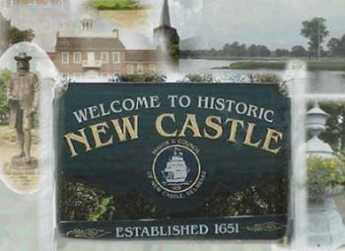
|
| New Castle, Delaware |
And yet it is a perfect jewel of early American history and architecture. It's just as attractive and historically important as Williamsburg, Virginia, except these buildings are not reproductions, but the real thing. The town says it was founded in 1651 by Peter Stuyvesant, but Peter Minuit in 1638 could make a claim to be even earlier. Located at the narrow neck of the funnel that is Delaware Bay, it was a natural place to start a colony, eventually to be the capital of the state. The Delaware River makes a rightward turn at that point, and creates a river highway all the way to Trenton. But a few miles upriver at Tinicum, now Philadelphia International Airport, the river started to fill up with islands and snags; was it better to locate upriver or downriver from the narrows? New Castle was placed downriver.
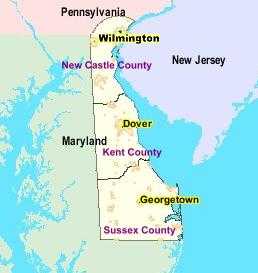
|
|
New Castle's courthouse is the epicenter of the arc from Maryland to the Delaware River. |
But in 1777 the British fleet came to visit with hostile intent, and New Castle could look out the windows along the Strand right into the mouths of ships with twenty or thirty cannons pointing at them. Philadelphia, on the other hand, was protected upriver by a series of mud flats and barricades at Fort Mifflin that could quite effectively bar passage to enemy sailing ships. Delaware got the point, and shortly thereafter, the capital of Delaware was prudently moved to Dover, while even the county seat of New Castle County was moved to Wilmington. New Castle had a big fire in 1824; rebuilding afterward accounts for much of the present uniformly Federalist architecture. The final nail in the commercial coffin of the town was driven by the Pennsylvania Railroad, which just by-passed the town. For a century, this little architectural jewel just sat there in the fields, until the narrow neck of the Delmarva Peninsula became such a transportation crossroads that the fields filled up with construction more appropriate to Los Angeles. New Castle disappeared, without moving an inch.

|
|
100 Harmony St., New Castle, DE 19720 (302) 328-2413 |
For fifty years in Colonial days, the rector of Immanuel Episcopal Church in New Castle was one George Ross. His son, also named George Ross became a lawyer in Lancaster and signed the Declaration of Independence. His widowed daughter, Gertrude Ross Till married George Read, a lawyer in New Castle who also signed the Declaration. And, a third signer Thomas McKean, lived two houses away. George Read had studied law under John Moland, whose house served as Washington's headquarters in 1777.
The northern border of Delaware is a semicircle, with a twelve-mile radius based on the cupola of the New Castle courthouse. It was originally the border of New Castle County, and it proved to be slightly imperfect. In the first place, it extended across the Delaware River into New Jersey, but it was a nuisance to go there, so that segment of land was abandoned to New Jersey. However, the legal border of the State of Delaware, therefore, extends to the high-water bank of the river on the New Jersey side, rather than running down the middle of the river. The significance of this curiosity appeared when the Delaware Memorial Bridges were built, and all of the tolls go to Delaware, instead of being split between the states as is more customary. The other problem with the semi-circular arc was that three lines meet at the northwestern corner of Delaware, and each was defined in its own way. The Mason-Dixon line goes due east-west, the border with Maryland goes north-south, and the idea was that the semicircular arc would meet the other two lines at a point. However, the instructions could be read in two different ways, leaving a little "wedge" of territory that could be reasonably said to lie in either Pennsylvania or Delaware, depending on the sequence of describing them. This was certainly a circumstance where any decision was better than no decision, but it took until 1921 for the states to harrumph their way to a final pronouncement. In the meantime, the disputed wedge of land was a good place to have duels, cockfights and other matters of questionable legality.
REFERENCES
| Lewes, Delaware: Celebrating 375 Years of History Kevin N. Moore ASIN: B006DL8TC6 | Amazon |
Pea Patch Island
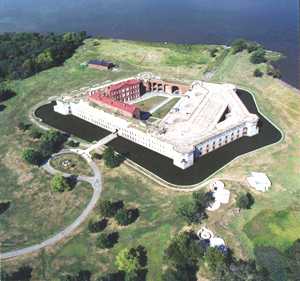
|
| Fort Delaware |
There's a tradition that a boatload of peas ran aground on the mudflats of Delaware Bay near Salem in the Sixteenth Century, turning the flats into a patch of peas. In any event, the island is known to have been growing in size for centuries, and now is home to about 12,000 families of Herons. The number of mosquito families has not been accurately counted as yet, but they are even more numerous. The island doubled in size when the Army Corps of Engineers built the present Fort Delaware on it in 1847-59.
The War of 1812, which included the burning of Washington DC and bombardment of Baltimore, propelled America into a frenzy of coastal defense, and the first fortification of Pea Patch Island took place in 1813. A plan was adopted by Congress in 1816 to build 200 coastal forts, and about forty of them were actually completed by the time of the Civil War. These forts all had a similar appearance; the most notable example of the style was at Fort Sumter near Charleston, South Carolina, which was nearly complete by the time of its famous bombardment. In fact, it was first hastily occupied by Northern defenders arriving just in time to be evicted. In essence, these forts were huge walls of bricks with a concrete outer shell, holding a couple dozen very large cannons and a parade ground.
The new river defenses of Philadelphia were to be provided by three forts, Fort DuPont at the mouth of the old Delaware-Chesapeake canal, Fort Delaware on the island, and Fort Mott on the New Jersey side. You can now take a ferry ride to all three, between April and September; it's a pleasant afternoon excursion. Not so many years ago, you had to go into an ominous little taproom in Delaware City and ask in a loud voice if someone wanted to take you to Pea Patch in a fishing boat. The scene was reminiscent of old movies about derelicts hanging out in Key West, complete with George Raft and Ernest Hemingway, but now the National Park Service has given it the characteristic NPS spruce-up, with pamphlets and restrooms.
The place never had any serious military activity except when it was used to house Confederate prisoners after the Battle of Gettysburg. Over 12,000 prisoners were brought there, and there were about 3000 deaths among them. Historians have compared the treatment of Confederate prisoners with the treatment of Union prisoners at Andersonville, Georgia, and it would be hard to say which place was worse. There are certain diseases of poor sanitation, like typhoid, cholera, amoebic and bacillary dysentery, and hepatitis, which decimate all concentration camps at all times. And adding to them the mosquito-borne diseases of both Delaware and Georgia at the time, you don't really need to assert prisoner mistreatment to account for the morbidity and mortality. Undoubtedly there was some of that.
Getaway

|
| Delaware Hospital in Wilmington |
Occasionally prisoners must be taken to the hospital, and that's a problem for the authorities. Philadelphia General Hospital had a special prison unit on its grounds, so the problem for the guards was merely to transport the prisoner to the locked hospital ward and bring him "home" after his medical problems were fixed. The State of Delaware doesn't have a prison unit in any hospital, so the security risk must be addressed by sending at least two guards, night and day, to some hospital, and securely manacle the prisoner to the bedstead. Nobody likes this situation, particularly the head nurses, but no one has a better solution to offer.
When prisoners have to make an outpatient trip for an x-ray or similar, there is usually an iron rule: no one is to know about it in advance. In one particular case, however, a convicted Delaware murderer had to have an x-ray of his gallbladder, which in those days required swallowing some large pills the night before. That was the tip-off.
On the specified morning, he was bundled into a patrol car with manacles and guards, and whisked off to the Delaware Hospital, now the Delaware Division of the Wilmington Medical Center. The x-ray department was at the end of a long corridor, with the diabetic clinic on the right and the bathrooms on the left side of that corridor. The entrance was on the side of this corridor, right next to the office for visiting consultants. Things were busy but peaceful that morning when a commotion arose. Three prison guards came marching through the door, surrounding their manacled prisoner. They turned left, and down the long hall to the x-ray department.
As they passed the men's room, the prisoner begged his guards to let him relieve himself, so they took him into the bathroom, removing the handcuffs. He washed his hands, dried them with a paper towel, pushed it into the waste container. Then quick as a flash he thrust his hand deeper into the crumpled waste paper, got the loaded revolver his accomplices had put there, and emerged from the wastebasket -- shooting. The guards got down on the floor, a bullet went into the Diabetic Clinic were a very prominent society lady was working in a pink volunteer's uniform, and another bullet went into the consultants' office, which on other days I might have been using. The escapee was running hard, fired one final bullet into the ceiling at the door, and was out in a second to the waiting getaway car where his buddies were ready. He got away clean, as they say.
There's nothing like an episode of that sort to bring people together. We were survivors of an exhilarating experience, having something in common that no one could take away. For a couple of years afterward, the bullet hole remained unobtrusively in the ceiling by the entrance. The nurses told me that workmen had arrived several times to patch it up, and the society lady, who was a trustee of the hospital, wouldn't let them fix it. That was our bullet hole.
Brandywine Museum
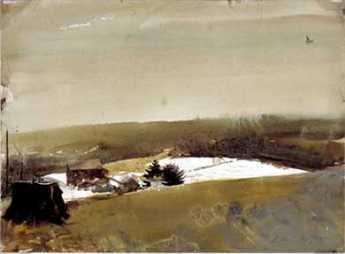 |
| Wyeth Ann's House |
Artistic talent must be inherited; some of us don't have any at all, while other families seem to have unusual talent in every member. Around Philadelphia, one notable example is the Peale family, and another is the Wyeth clan. Three generations of Wyeth's show their work as a group in a former Brandywine Creek grist mill which has been elaborately restored and enlarged for the purpose. Using large glass windows, part of the display is the Brandywine Creek itself, with the high banks that once made it seem like a perfect defense line for George Washington in the biggest battle of the Revolutionary War. Outside the museum entrance are several of those inevitable Delaware tip-offs, large millstones that may in this case have ground grist, but often were used to grind gunpowder.
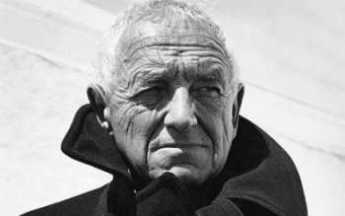 |
| Andrew Wyeth |
Andrew Wyeth spent much of his early career doing watercolors and then turned to tempera as re-popularized by N.C. Wyeth, his father. That's a fairly drastic change, since a watercolor must be completed in one sitting before it dries. Oil base paint dries slowly and allows the painter to work on a piece for a number of days. Tempera, using the protein in milk and eggs to hold the pigment, dries hard and fairly quickly. But another layer of tempera can be painted on top of the hardened base layers, making a glowing effect possible, a peculiar luminosity if the artist chooses to bring it out. Andrew Wyeth migrated to what he called dry-brush, where the paint on the brush is mostly squeezed out, so extremely detailed fine lines can be painted. Thus, he spent his early years with fast blurred watercolors, and the rest of his life with meticulous slow painting, where detail is everything. He chose to use this technique to produce a haunting silent scene, even if it contained people. His son, Jamie, tends to emphasize dancers so you can see the typical family rebellions alternating between generations, at the same time that the Wyeth's (and Howard Pyle, the artistic forefather) preserve strong family unity. From what the neighbors say, there were plenty of family clashes, but that's artists for you.
Fanny Kemble Takes the Train South, in 1838
The "Journal of a Residence on a Georgian Plantation in 1838-1839" raised strong feelings against slavery, particularly in Frances Anne Kemble's native England. At the outset of her book, Fanny Kemble describes what it was like to travel on American railroads in 1838.
On Friday morning December 21, 1838, we started from Philadelphia, by railroad, for Baltimore. It is a curious fact enough, that half the routes that are traveled in America are either temporary or unfinished -- one reason, among several, for the multitudinous accidents which befall wayfarers. At the very outset of our journey, and within scarce a mile of Philadelphia, we crossed the Schuylkill, over a bridge, one of the principal piers of which is yet incomplete, and the whole building (a covered wooden one, of handsome dimensions) filled with workmen, yet occupied about its construction. But the Americans are impetuous in the way of improvement and have all the impatience of children about the trying of a new thing, often greatly retarding their own progress by hurrying unduly the completion of their works, or using them in a perilous state of incompleteness. Our road lay for a considerable length of time through flat low meadows that skirt the Delaware, which at this season of the year, presented a most dreary aspect. We passed through Wilmington (Delaware) and crossed a small stream called the Brandywine, the scenery along the banks of which is very beautiful. For its historical associations, I refer you to the life of Washington. I cannot say that the aspect of Wilmington, as viewed from the railroad cars, presented any very exquisite points of beauty....
And first, I cannot but think that it would be infinitely more consonant with comfort, convenience, and common sense, if persons obliged to travel during the intense cold of an American winter in the Northern states, were to clothe themselves according to the exigencies of the weather, and so do away with the present deleterious custom of warming close and crowded carriages with sheet iron stoves, heated with anthracite coal. No words can describe the foulness of the atmosphere...Of course, nobody can well sit immediately in the opening of a window when the thermometer is twelve degrees below zero yet this, or suffocation in foul air is the only alternative...
We pursued our way from Wilmington to Havre de Grace on the railroad, and crossed one or two insets from the Chesapeake, of considerable width, upon bridges of a most perilous construction, and which, indeed, have given way once or twice in various parts already. They consist merely of wooden piles driven into the river, across which the iron rails are laid, only just raising the train above the level of the water. To traverse with an immense train, at full steam-speed, one of these creeks, nearly a mile in width, is far from agreeable...At Havre de Grace we crossed the Susquehanna in a steamboat, which cut its way through the ice an inch in thickness with marvelous ease and swiftness and landed us on the other side, where we again entered the railroad carriages to pursue our road.
Battle of the Clouds: September, Remember
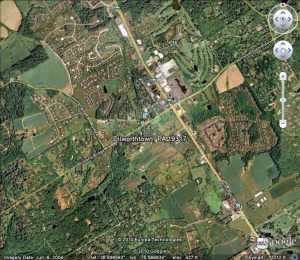
|
| Dilworthtown |
Weather satellites, television and so on have taught us much about hurricanes that was unknown in 1777. Benjamin Franklin, it should be noted, was the first to observe that Atlantic Coast "Nor'easters" actually begin in the South and work North, even though the wind seems to be blowing in the opposite way; what's moving toward the northeast is a low-pressure zone. We now know that hurricanes begin in Africa, travel West and then veer North when they reach Florida. A great deal is still to be learned about hurricanes, but the most important thing about their timing is contained in a maritime jingle:
June, too soon.
July, stand by.
And then: September, remember.
October, all over.
Along the Atlantic east coast, the end of August to the middle of September, is hurricane season. That's when houses blow down in Florida, and heavy rains hit Pennsylvania. Admiral Howe might have had some clue to this, since Franklin made his observation around 1750, and storms are important to Admirals. But very likely his brother the General just thought it was one of those things when the British landing at Elkton, Maryland in late August 1777 was greeted with an unusually severe downpour of rain. Howe had planned to surprise Philadelphia from the rear by hitting the ground running on horseback. However, he underestimated the debilitating effect on the horses of three weeks at sea on sailboats; to unload and forage horses during a hurricane was almost too much for the plan. For that purpose, he had given orders for the troops to disembark without waiting to pitch camp, or unpacking their gear. But the drenching rain gave Washington several extra days to organize a defense, although he has been given too little credit for the strenuous accomplishment of moving an army from Bucks County to the banks of the Brandywine in that weather. Howe, whose trademark was surprise, deception, outflanking, had anticipated a sudden cavalry thrust into the backyards of unprepared Philadelphia. What he got was 2000 casualties in the biggest battle of the Revolutionary War, against Washington's well-prepared defense along the steep-sided Brandywine Creek.
Howe won this battle, in the sense that Washington was forced to withdraw, because Howe employed another British military trademark, of driving his own troops beyond humane limits in a huge outflanking movement. The countryside around Kennett Square is hilly and broken almost to West Chester, and the American Army felt reasonably prepared along a front of ten or twelve miles. But Howe drove the main force of his army seventeen miles to the north, to Dillworthtown, before turning the unprepared American right flank. And, in the now hot August weather in full uniform and battle pack, the drive continued for twenty-four consecutive hours until Washington saw he had to withdraw. This was what the British meant when they boasted of seasoned regular troops; you win by enduring more than your opponent can endure.
One has to have equal admiration for Washington. Although he was dislodged from his position, losing the opportunity to catch the British in a hostile region without a reliable source of supplies once the fleet weighed anchor, he preserved his army of marksmen and deer hunters intact during the retreat. The two armies started at roughly the same size, and Washington had only about 1300 casualties; his men had more certain supply sources, and they were fighting for their homes. The British, somewhat outnumbered, had the prospect of fighting their way without resupply through an enemy's home territory, capturing the enemy's capital, but still facing the possibility that the British fleet might not get past the Delaware River defenses. If that happened, they could celebrate their victory by starving to death. Just about the only weakness of the Continental Army was its discomfort with bayonet warfare. They could hit a squirrel at a hundred yards, but those long bayonets on the end of very long muskets were designed to protect foot soldiers from cavalry charges. It takes training to put the butt of the musket against a stone on the ground, hold your ground against an oncoming gallop of horsemen, and trust that at the last moment the horses will rear back and throw the riders. But it also takes naked bravado to wave a sword and ride full tilt into a forest of pointing bayonets, trusting that at the last moment the defenders will break and run.
But Washington knew what he was doing. He pulled the troops back to Chester, then over the Schuylkill to the Germantown encampment at Fox and Queen Lane, then up the Schuylkill to Norristown, the first ford in the river that Howe must use when the boats and bridges were destroyed. The river would hold the British while the Americans came at them from the rear; this was essentially the same river strategy he used at the battle of Trenton. Washington picked his battlefield in Chester County and got ready to fight the second installment of the Battle of Brandywine. The campus of Immaculata University now occupies the site.
And then it rained, again. Hard. The gunpowder on both sides was soaked, useless. In what has come to be known as the "Battle of the Clouds", the fighting was called off by mutual agreement. The second hurricane of the year had arrived, and Washington more or less helplessly had to watch Howe take over Philadelphia unopposed. He lost the capital, provoking dismay among the colonists, but his masterful strategy taught the British to respect him. When the British were later considering whether to hold or abandon Philadelphia, this growing respect for their adversary helped tilt their thinking toward prudence.
But that was not before Howe once more showed he too was not the lazy slacker that others had called him. General "Mad Anthony" Wayne was dispatched with fifteen hundred troops to hassle the rear of Howe's army. Wayne was confident he could hide his troops in the Radnor area where he had been brought up, but the region in fact had many Torys to report his movements. Howe ordered Major General Lord Charles Grey to take the flints from his troops' muskets, attack the American camp near Paoli's tavern in the night, and use only bayonets. Waynes' troops were scattered and slaughtered, in what came to be known as the Paoli massacre.
Day Two: Rehoboth to Kennett Square
 So, if you want a glimpse of Delaware as it once was before the migrations, get in your car quick and take the tour.  |
Once you step off the Cape May-Lewes Ferry in Delaware, you can still find an occasional old soul who remembers when "the road" was built. The road they mean is the highway that finally connected Southern Delaware to Wilmington. Before 1925, travel between the two ends of that little state was by railroad, or by boat, mostly the Wilson Line. It is natural to suspect the railroad and the boat line might have lobbied against road building, and they certainly had an economic incentive. But there were social factors, too. Although it is a tiny state, Delaware has long been a collection of independent tribes. New Castle County is of course very Ivy League; the Wilmington area claims to have more PhDs than any other American county. Southern Delaware was a slave region, forcing the state to be in favor of the Union, but also in favor of slavery -- a border state. Furthermore, pirate lairs seem to have created a mixed race along the shore calling themselves "Moors"; intermarriage with Indians and/or Portuguese pirates has been speculated as a source of swarthiness. Along the Atlantic coast, it is claimed that pure Elizabethan English is still spoken. Furthermore, the maritime orientation of Lewes created more social affinity to Cape May and Philadelphia than to New Castle and Wilmington. Eastern shore Maryland was even closer. Finally, in 1923, Coleman DuPont gave up on persuasion, built a 98-mile highway from one end of his state to the other at a cost of $50,000 a mile, and just gave it to the state. The legislature at first wouldn't take it, thinking it was clever to let the rich DuPont fellow pay for its upkeep. However, the sight of a DuPont cavalry of highway patrolmen raised even more discomfort, so the legislature reconsidered, accepted the gift.
The legislature was right, in a perverse sort of way, because Wilmington folk promptly poured down to the beaches in the summer, to the duck blinds in the fall, retirees built houses where living was cheaper, southern Delaware children wanted to go North to college, the blonde girls of Swedish or Dutch ancestry went north to become someone's secretary, maybe marry him. The railroad and the boat line went bankrupt, segregation was declared unconstitutional, everybody got television and a pickup. Eventually, someone in the Chamber of Commerce got the idea of jiggering tax laws to encourage out-of-state retail, then banking, then credit cards. The transformation of Delaware into a tax haven brought welcome socio-economic competition to the monolithic Dupont Company, abating the benign hereditary aristocracy that had grown out of it. So, if you want a glimpse of Delaware as it once was before the migrations, get in your car quickly and take the tour. There have even been rumors that the Cape May ferry may close.
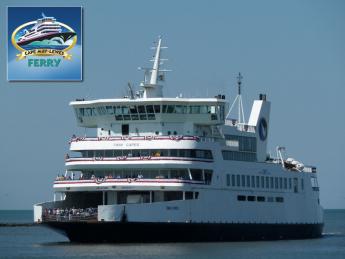
|
| Lewes Ferry |
Lewes was once a little seaport, but mostly a home for river pilots. There is a canal across the base of Cape Henlopen peninsula, and the pilots' imposing houses line the canal. But vacationers and sportsmen are now building waterfront houses as fast as they can, so old Lewes is getting lost. Rehoboth down the road has ocean beaches and higher land, so it offers suburban living at the beach, year-round. We don't plan to visit nearby Georgetown on this tour, but it's only ten miles away and presents an interesting legal anachronism in the Court of Chancery, for lawyers and historians to admire.
To take the Delaware turnpike from Lewes to Wilmington is quicker, but history is to be found by winding along Route 9, through the moors, marshes, and farmland. The Wesley Chapel is a place where John Wesley really preached in his tour to extend Anglicanism, and unintentionally to found the Methodist Church. The Bombay wildlife sanctuary is an interesting place to see migrating birds, although the birds may enjoy mosquitoes more than you do. You will be astonished to learn there were once so many peach trees in this area that Delaware was nicknamed the Peach State. Just outside Dover is the Air Force base, which somehow specializes in mortuary affairs during shooting wars. But there are real warplanes there, too, as became very evident during the Cuban Missle crisis. The sky seemed filled with huge eight-engine bombers, just circling around, waiting for orders to go lay an egg or two. The Air Force Base is a peculiarly international community to be living in rural Delaware; a pilot making regular trips to Guam had no difficulty keeping monthly appointments with me for a while.
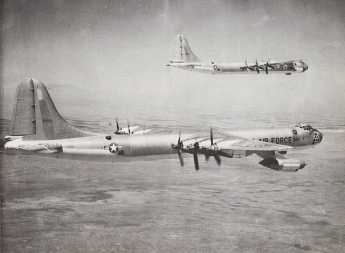
|
| bomber |
If you watch for directions just south of the airbase, you can travel out in the farm country to the Delaware estate of John Dickinson. As a young man, Dickinson fought a bitter battle in the Pennsylvania Assembly against Benjamin Franklin's efforts to remove the Penn Family from control, and although he lost the King's decision, winning that decision caused Franklin to be essentially banished to England for years as a consequence. Much later, Dickinson swung the critical vote toward Independence by abstaining from voting on the point at the Continental Congress, but wouldn't sign the Declaration. Nevertheless, he volunteered to fight as a private when the British invaded. He started and ended life as a Quaker but was the richest man in the state in between times, was Governor of Pennsylvania and Delaware at the same time, freed his slaves but kept secret the discovery that it actually made his farms more profitable to hire farm workers. A truly remarkable person, living in what you will see were rather plain circumstances.
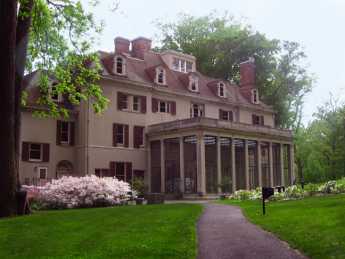
|
| Winterthur |
Dover itself is worth a quick trip to the colonial heart of it unless you become engulfed in traffic to the race track. Then a quick visit to the Blackbird pirate sanctuary of the pirate Blackbeard, and on to Odessa and New Castle, which are both real jewels. You can scarcely miss Odessa, which is at the narrowest neck in the Delmarva Peninsula, an isthmus that necessarily must eventually choke up with highways; Odessa has a Christmas festival worth a trip just for it. New Castle is far more uniform in appearance because it burned shortly after the Revolution and was rebuilt in pure Federalist style, then froze in time when the capital moved to Dover.
Then, skirt around Wilmington to the chateau country and try to decide between visiting Winterthur, Longwood Gardens, the Brandywine (Wyeth) Museum, the Brandywine Battlefield, and the mushroom area around Kennett Square. Generally speaking, Winterthur is at the top of the list.
If you left enough time, you may want to circle back through the Main Line suburbs, or through Swarthmore, to Chestnut Hill and Germantown, then down to center city Philadelphia. However, you may be tired, and just want to buzz back from Kennett Square by way of I-95.
Philadelphia Gardens
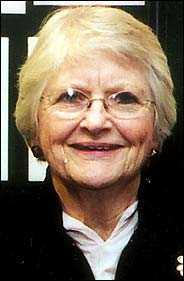
|
| Ernesta Drinker Ballard |
There are many show gardens, mainly on former large estates, scattered around the United States, and the ones on Southern plantations are quite famous.
However, the fact of gardening is that the climate has a lot to do with success. The really premier gardens of America are found in an East Coast strip from northern Virginia to southern Connecticut, with Philadelphia in the center of things. There is also a good-gardening area from Oregon to British Columbia, with a particularly notable garden in Vancouver, named after a sort of Philadelphian named Inazo Nitobe whose story is related in another blog. To have a really notable variation of exotic display plants, you need a lot of rain, a long cool spring, and a tradition of cultural association with the British Isles. Alkaline soils, generated by limestone, will produce a fine lilac display. Denmark would be a good place to go see that, but most of the show gardens in America are based on acid soils, with dogwood and azalea the predominant background coloration in May and June. A visitor from Michigan was once heard to ask what all the pink bushes were around Philadelphia, so it's likely the soil is not acid in Michigan. On the other hand, Korea is where wild azaleas originally came from, making the acid-soil hills crimson in the spring there. It should be noted in passing that Japan, Korea, and the Delaware Bay are on the same 40-degree latitude, but Japan escaped the loss of species caused by glaciers of the ice age.
Many of the Philadelphia suburbs have thousands of azalea bushes in each town, and hundreds if not thousands of pink and white dogwood, or purple Empress Trees, or magnolias. When you have a lot of those as background to start with, you are ready to begin planting a show garden. For that, we can largely thank John Bartram the botanist, one of the earliest Philadelphia settlers. The grounds of Friends Hospital are particularly notable for azalea display, and the Pennsylvania Hospital is pretty good, too. Although they are closer to Wilmington, the two most famous show gardens in the Philadelphia area are on DuPont properties, Winterthur, and

|
| Longwood Gardens |
Longwood Gardens, They feed you pretty well in the associated restaurants there, and the bookstores and gift shops are truly outstanding. But what in many ways is the best show garden in Philadelphia is Chanticleer, the former estate of a family that founded what is now Merck Pharmaceuticals, located in the suburb of Wayne, across the street from where Tracy Lord, the heroine of The Philadelphia Story, lived on two square miles of the Main Line.

|
| Philadelphia Flower Show |
It's not clear why Chanticleer is such a well-kept secret, but it's sure worth the trip to see it at almost any season, May preferred. Interest in gardening is not limited to just a few big estates, it's a Philadelphia sport. Therefore it's not surprising to learn that the largest flower show in America is held in Philadelphia at Convention Hall in the Spring. If your feet aren't flat when you go in, they will surely be flat when you come out because a complete tour would be miles long, threading among the aisles. It's not easy to guess how much money each exhibitor spends on a display, but it's surely not a cheap hobby when you get to this level. If you notice the landscaping on public grounds in the city, it's always a fair guess that it was paid for by the profits generated by The Flower Show. Almost everybody has heard of the Burpee Seed Company, and Mr. Burpee summed up the prevailing attitude of Philadelphia gardeners: "If you want to be happy for a day -- get drunk. If you want to be happy for a week -- get married. But if you want to be happy for a lifetime -- get a garden."
REFERENCES
| Gardens of Philadelphia and the Delaware Valley William Klein Jr. ISBN-10: 1566393132 | Amazon |
Secret Places

|
| Winterthur |
Most mansions and other imposing places are clustered together in what would be called the high rent district. In the course of time, such areas often decline, but an occasional mansion remains nestled in a commercial or industrial area, or even in a slum. If it's accidentally well designed for such a fate, it might have an elaborate interior courtyard with a shabby exterior, or it might be in some cul-de-sac of a creek, or behind a hill. Unnoticed, it thrives as a social island. Eventually, someone notices the principle of hiding in plain sight, and creates a place like that deliberately.
Perhaps the most common examples of this approach are found in the "chateau district" of northern Delaware using what is called berms. These consist of large artificial hills which have been bulldozed up between the road and the chateau, effectively hiding them from passers-by. Both Winterthur and Longwood Gardens are hidden behind hills. If you get a chance to fly over the area in a private plane, you will be surprised to find that what looks like rolling rural countryside actually has quite a few mansions tucked away in it. It's safer that way, more private, less ostentatious. The DuPont family might even still harbor a few recollections of the French Revolution, or the barricades of the Paris Commune.
Up around Gulph Mills, the Drexel family had a place within a hidden valley, sort of like the crater of a volcano. The area nearby has since been built up with moderate-sized suburban houses, and between two of them is what looks like a driveway, going far to the back. In fact, it goes over the side of the bluff and down into a many-acred hollow. When you are inside the hollow, you could be a hundred miles into the wilderness and feel no more secluded. The only real problem with this arrangement is that visiting guests can be standing right in front of the entrance and never realize they have arrived; that's what cell phones help with. Global positioning (GPS) sounds ideal for the purpose, but when the trees are leafed out you are likely to think the GPS is broken. There is a farm in Germantown, behind LaSalle College, not far from Albert Einstein Medical Center. For tax purposes, it has a cow wandering around. Every once in a while LaSalle students think it is hugely amusing to steal the cow and put it on the top floor of a dormitory. But as you drive up Broad Street, most people would guess that the nearest cow is many miles away.
Although you have to go to New York to see the principle carried to its extreme, there are a number of places in downtown Philadelphia which combine the urban principle that doorways should be inconspicuous with the principle that if the streets are narrow, you really can't look upward very well. The New York example is right next to Carnegie Hall, seventy stories high but can't be seen from the street because of the angle. Furthermore, this apartment building occupies the center of the block but is turned so that only the corner of the building reaches the street. The entrance to this fanciest of fancy apartments is thus only one storefront wide, nestled inconspicuously among a long row of shops. Here again, the only problem is for visitors, because taxi drivers can't find it. To protect the innocent, we won't identify the places in center-city Philadelphia that use the same principles of concealment without exactly hiding.
Here's a tip. There are many houses next to parkland in Philadelphia where it is possible to see a dozen deer in the back yard, every morning. Forget about Lyme Disease; those are nice places to live.
Furniture for the Horse Country

|
| Douglas Mooberry |
Low-end furniture for America is now mostly made in China, and seldom made of wood. Truly American cabinet making tends to be high-end, and high priced. That tendency goes to some sort of extreme around Unionville in Chester County, where a 25-year old company named Kinloch Woodworking holds pride of place. The owner, D. Douglas Mooberry, picked the name Kinloch at random from a map of Scotland, but his selection of southern Chester County was not an accident. The influence of nearby Winterthur has infused that whole region with an interest in fine furniture craftsmanship, and museums like the Chester County Museum and others throughout the nearby Pennsylvania Dutch country provide an ample source of authentic pieces to serve as examples. There's one other factor at work. As Doug Mooberry quickly noticed, people with money usually have lots of it. There really is a market for $28,000 tall case clocks, $18,000 highboys, and $12,000 tables -- if you can convince people in Chester County you are really good.
Although this 12-person company repairs antique pieces, it does not make exact reproductions. It produces new pieces in the old style of the region, based on careful analysis and evaluation of museum pieces from earlier times. Kinloch once aspired to equal the quality of the early artisans, but now aspires to surpass them in quality of materials and workmanship. The more conventional stance of fine artists is to attempt to excel in today's current style, whatever that may be, probably "post-modern". Kinloch artists, however, choose to excel in the style of a long-past era, taking care not to claim the product is antique. Artisans grow up in cooperative clusters; there's a world-famous veneer company nearby and a pretty good hardware company, although the best craftsmen of furniture hardware are still found in England.
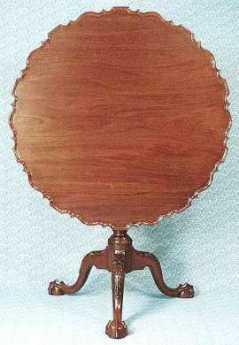
|
| Chippendale Table |
The characteristic style of Chester County furniture in the Eighteenth Century was a mixture of two neighboring cultures, Queen Anne, Chippendale, ball and claw Georgian style of Philadelphia; and the "line and berry" inlay style of the Pennsylvania Germans. If carefully executed, this hybrid style can be very pleasing, and you had better believe it requires painstaking craftsmanship. Others will have to explain the significance or symbolism of intersecting hemi-circles in the lines, and the inlaid wood hemispheres, the berries, at the end of the lines. But the technical difficulty of laying strips of 1/16 inch wood in curved grooves only a thousandth of an inch wider, or the matching of 3/8th-inch wood hemispheres into hemispheric holes gouged out of the main piece -- making the surfaces of the inlays perfectly smooth -- is immediately obvious to anyone who ever tried to whittle. Ultimately, however, true artistry lies in combining two unrelated styles without producing an aesthetic clash. By the way, you would be wise to wax such furniture once a year.
The factory is on Buck and Doe Run Road, and here's another culture clash. At one time, Lammot du Pont cobbled a 9000-acre estate out of several little country villages. In 1945 it was sold to the Kleberg family of Texas, the owners of the King Ranch. Robert Kleberg was an admiring friend of Sam Rayburn but treated the oafish Lyndon Johnson as his personal political gofer. From 1945 to 1984 Buck and Doe was used as one of several remote feedlots for Texas Longhorns bred to Guernseys, the so-called Santa Gertrudis breed. Originally, Texas cattle were seasonally driven to Montana for fattening, then on to railheads for the stockyards. As farmers began to build fences interfering with the long drive over the prairies, it became cheaper to fatten cattle closer to the markets. So satellite feedlots like Buck and Doe Run were developed. You can pack more cattle in a rail car when they are younger and smaller, and advantage can be taken of price swings by suppliers who are close to the market. In this case, the markets were in Baltimore. Since the King Ranch is larger than the state of Rhode Island, such 9000-acre farms were pretty small operations in the view of the Texas Klebergs, an opinion they did not trouble to conceal from the irritated local gentry. The point was even driven home in high society circles by holding large parties at Buck and Doe Run, allowing guests to wander around the roads, unable to find the house of their host even though they had been on his property for most of an hour. In 1984 the Buck and Doe was sold to Art DeLeo, who is busily converting it into a nature conservancy.
Hedge Funds in Delaware

|
| Trimming the Hedge |
Some day a shrewd observer of the passing scene will notice the peculiar quality which attracts some businesses to the state of Delaware and coin a catchy phrase like Delaware Attractiveness to describe it in a nutshell. It surely underlies the way major national corporations predominantly incorporate under the laws of Delaware; other states don't like that. It probably accounts for the unusual accumulation of national credit card companies in that little state. Right now, it must be surmised to account for 24% of American hedge funds locating in Delaware. Just what is Delaware Attractiveness?
James Madison, the main author of our national Constitution, disliked taxes and debt and celebrated the ability of taxpayers to move to a different state if their home state raised taxes too high. The right to migrate away acts a discipline on state governments tempted to abuse power. A good example now exists in New Jersey, where one percent of the population pays 42% of the taxes, and that one percent is moving out of New Jersey as fast as it can. Eventually, that same 42% of taxes will be redistributed to those who remain, and something will be done about New Jersey state expenditures.
So conversely, little Delaware once had few corporations and little to lose by lowering corporate taxes. Soon, these low taxes attracted corporations from other states to incorporate in Delaware. When credit cards were invented, they were attracted to Delaware by low taxes, gentle regulation, and fair-minded courts. They were non-polluting businesses who employed a lot of rural labor made available by enhancements in agricultural productivity. One member of the Delaware Chamber of Commerce once mused, if it would attract the right sort of business, any hampering state legislation could be changed over a weekend.
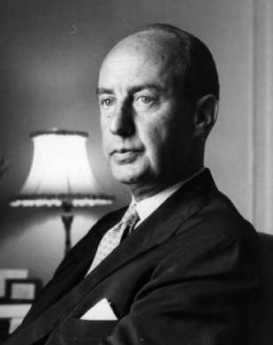
|
| Adlai Stevenson |
This spirit of the American Liechtenstein attracted 24% of hedge funds to Delaware before most people knew what a hedge fund is. Without delving into the full complexity of the subject, a hedge fund addresses the instability of investing for the long term with short term money. Promising higher returns than mutual funds which can generally be liquidated overnight, a hedge fund locks the investor's money up for several years and hence needs to tell its competitors (and unfortunately also the investor) comparatively little about what it is doing with his money. One hedge fund operator stoutly defended the need to keep others from knowing his positions, illustrating how competitors who knew his positions would destroy him by "front-running", typically by flooding his positions with sell orders about ten minutes before or after the closing bell on the stock market. And, indeed that was a realistic concern since 70% of current stock trading is performed by unattended computers, who can transact huge sales in seconds when they detect unusual patterns of activity. So, when the stock market crashed in 2007-2009, Congressmen were pressured to find scapegoats. Some blamed computerized trading, and some blamed hedge funds. Quite possibly, it was neither one, since hedge funds were comparatively unaffected by the crash, and "programmed" traders made a great deal of money. However, Delaware is discovering that anyone who visibly escapes a nation-wide panic is under suspicion of causing it, and must fight off hostile legislation at least until the full facts emerge. The ability to front-run, and the ability to avoid having it happen to you, constitute a business advantage, an "edge". There may be more to it than that, but other features are cloaked in the secrecy which hedge funds enjoy, so secrecy is the business plan of hedge funds, apparently more tolerantly treated in Delaware than elsewhere. The price which hedge funds pay for their right to secrecy is the limitation imposed on them by the regulators as to who may be their customers. Therefore, an acceptable hedge-fund customer gets defined as a rich sophisticated person, who knows what risks are involved, and can afford to lose his money. Being in a small, closely-knit community where word of mouth is trusted, adds some degree of safety too. Adlai Stevenson once made an observation about trusting such protections:
In the past it was said, a fool and his money are soon parted. But nowadays -- it could happen to anyone.
Go to Delaware, Elephants?

|
| Dead Elephant |
No one is supposed to know where elephants go to die, but if they are smart as people say they are, my suggestion is to search for dead elephants in the state of Delaware. Most taxes, and estate taxes, in particular, are considerably lower, there. At least this was the message Christopher J. Topolewski, Esq. conveyed to the Right Angle Club recently. His firm, West Capital Management, has prepared a table comparing the taxes in the three states that come together at the southeast corner of Pennsylvania, which for residents of the Philadelphia area are within easy commuting distance of each other. Although Delaware has a marriage penalty (one couple is taxed more than the sum of two singles), it has no estate tax at all, no sales tax, and a property tax rate only half that of Pennsylvania, only a quarter of that in New Jersey. For residents of New Jersey, there is almost no tax which is not lower in Delaware, because but ex-Pennsylvanians would then have to be careful to die or cohabit since ordinary income tax and capital gains taxes are higher in Delaware than Pennsylvania. If you must die (and who doesn't?), go die in Delaware.
This was a situation specifically contemplated as a way to discipline greedy state governments, by James Madison when he was formulating the U. S. Constitution. And there is evidence it is working. By happenstance, I once encountered an official of New Jersey taxation, who told me that 43% of New Jersey taxes are paid by 1% of the population. And that 1% was moving out of the state as fast as it could. If it does, the other 99% of New Jersey residents will find their taxes rising by 43%. West Capital reports that taxation as a percent of income is 1.23% in Delaware, 3.46% in Pennsylvania, and 5.82% in New Jersey, suggesting that a selective flight of the 1% would raise the state taxes of everyone else by 43%, and thus make state taxation as a percent of lowered average income rise to roughly 20%. Relating total income to total tax revenues would be an even better way to detect hidden indirect taxes, such as overtaxing utilities in the knowledge it will be passed on to the consumer. I recently discovered that a few years ago, the Legislature got tired of hearing complaints about local taxes, so they transferred half of the local taxes to the state tax. That's pretty much like taking it from one pocket and putting it into another because now all the hubbub is about state taxes. Armed with even partial information, it becomes easier to understand why New Jersey would evict a governor who had been Co-chairman of Goldman Sachs, during a financial crisis. If a financial whiz can't change this, maybe it requires a meat ax.
This is a time of growing restlessness about public spending, and Tea Party revolts are likely to accelerate during the remaining nine months before the next election. The conjecture is growing about a coming deadlock between a Republican Congress and a Democratic President, lasting at least two more years. What might emerge from a strong third party congressional delegation is too arcane to discuss. But at least the Republicans who leave can console themselves they are selectively raising the taxes of Democrats.
It seems almost inconceivable that professional politicians would demonstrate such a forest of tin ears as to let this happen, but the rest of Mr. Topolewski's talk just heated up the fire. His long-scheduled talk was designed to give guidance about the new estate tax laws, but he found himself confounding his audience with the news that there are no new estate tax laws; in fact, there will be no estate tax laws at all after this year unless they emerge from the congressional gridlock we already have. Which apparently will be followed by a gridlock we can scarcely imagine. Imagine asking your lawyer to write a will which straddles the contingencies that there will be no law, that there might be a continuation of the present one, or there might be some new law of quite uncertain wording. One of the suggestions offered is to allow your executor the discretion to accept or disclaim certain hypothetical provisions.
And that brings up an old story. William Penn was the largest private landowner in the history of America, possibly the whole world. He had a trusted agent, who gave him an enormous pile of papers to sign. A busy rich man like Penn is regularly confronted with a discouragingly large number of routine legal documents to sign. So, Penn signed them all, not noticing that one of the various papers in the pile gave the entire state of Pennsylvania -- to his agent. The outcome of the ensuing uproar was that Penn spent six years in debtors prison.
Port of Philadelphia
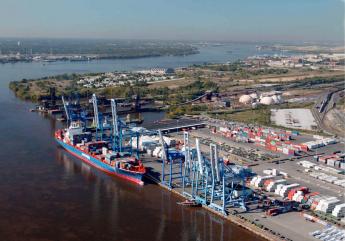
|
| Ports of Philadelphia |
When federal appropriations are doled out, it is a great advantage for the Port of Philadelphia to appeal to six U.S. Senators. However, the overlapping control of port operations can come close to paralysis. In short, we may have less chance of agreement on what we want -- but a greater chance of getting it. Right now, the ports of the world are struggling to adjust to revolutions of containerized cargo and gigantic oil tankers, plus political pressure from concern about the environment.
Some of the main arenas of our gladiator fights are as follows:
DRPA: The Delaware River Port Authority operates several large bridges, the PATCO high-speed subway line, and the cruise terminal, all leading to control of potentially large sources of revenue. The 1992 Congress expanded its charter to include the economic development of the port region.
SJPC: The South Jersey Port Corporation owns two marine terminals in Camden, and is planning a third in Paulsboro.
DSPC: The Delaware State Port Corporation operates the Port of Wilmington, DE.
PRPA: The Philadelphia Regional Port Authority has little to do with city politics, but is an arm of the state government of Pennsylvania, operating 7 marine cargo facilities, and planning more.
In addition, every county, city, and town along the riverbank has some degree of authority. Every business and union involved in regional or international trade is desperate to protect its interest in the politics of port regulation. Lately, the Homeland Security Agency has taken a large role. Scientists, engineers, fishermen, oil refinery operators, economists, and others abound. The news media convey their own opinions and the opinions of others. Opinions abound because most issues about ports are important.
In addition to the traditional cargoes of coal, petroleum, iron ore and forest products, which are mostly declining in importance, the rising cargoes include meat, cocoa beans, and South American fruit. General, or casual, cargo tends to be more valuable than bulk cargo, but greatly complicates the Homeland Security risks. The ratio of imports to exports is important because it is expensive to have a ship return empty. Shippers will, therefore, favor a port where there are expectations of return cargo. Oil tankers are particularly likely to return empty since their ballast is mostly river water; but, who knows, perhaps global warming will make dirty river water seem valuable to some tropical oil producer. A quirky problem is that most of the crude oil entering East Coast ports are currently coming from Nigeria, a notoriously corrupt nation. This has led to a thriving business of car-jacking in the Philadelphia suburbs, with the stolen cars promptly packed in empty containers returning to Africa.
Of the 360 major American ports, the Delaware River ranks second in total tonnage shipped, and eighth in the dollar value of the cargo. Every year, 2600 ships call into our port, which claims to employ 75,000 people. According to Bill McLaughlin of the PRPA, the future of the port will depend on the settlement of three major disputes:
1. Deepening the Channel. The historical natural level of the river is 17 feet, artificially deepened to 40 feet up to the level of the Walt Whitman Bridge. It sludges up by two or three feet every few years, so dredging is a continuous issue. The enlargement of tankers and container ships has led to a need to deepen the channel to 45 feet. It is true that the Wissahickon schist pokes up at Marcus Hook and will have to be blasted out, but mainly the issue is dredging up the gunk on the river bottom, and hauling it away somewhere. In Delaware Bay below Pea Patch Island, the bottom is sandy and hence valuable. The State of Delaware has plans for riverfront development, and would actually like to have the 8 million tons of sand, so no problem. The 7 million tons of clay and silt which must be dredged out of the upper Delaware River channel for a 45-foot depth is more of a problem, but users can be found for most of it. Or so the Pennsylvania representatives maintain; the New Jersey representatives led by Congressman Rob Andrews say it would be an environmental disaster to dump a thimbleful on New Jersey. Feelings get pretty hot in these things. The Haddonfield representative is portrayed as selling out his district in order to further his own state-wide aspirations, acting on the orders of North Jersey politicians who dominate New Jersey politics, who want to lessen competition with the Port of New York, which also shares a border with New Jersey. Feelings are not soothed to see the Port of New York deepening its channel to fifty feet while resisting forty-five in the Delaware port.
The document currently at the center of this interstate dispute is called PCA, the Project Cooperation Agreement. New Jersey won't agree to sign the proposal, which contains clauses to remove the DRPA from authority and replace it with PRPA(essentially transferring control and revenues from Philadelphia to the State of Pennsylvania) as the "non-federal sponsor". PRPA would then enter into a contract with the Army Corps of Engineers to get the work done.The price, probably low-balled, is $219 million, to be compared with the Port of New York's dredging price (probably high-balled) of $50 billion. There are, of course, a great many features of this political negotiation which are unlikely to appear in print.
2. Southport. The grand plan for the Philadelphia Port is to center on an intermodal complex of piers, railroads, and highways which would extend as a continuous terminal from the Walt Whitman Bridge to the old Naval Yard. No doubt this idea is linked to the round-the-world concept of Philadelphia as a way station from India to Vancouver, overcoming the empty return cargo problem by never looking back. Good luck.
3. Monetizing the Port. Like the turnpikes, ports could be sold to private investors. Of course, that could extend to selling the property to foreign investors, triggering the nationalist reaction readily observed when port management was once offered to Abu Dahbi. It could well give a new meaning to the expression, being sold down the river, but who knows maybe it's a good idea. When you criticize motives it never bothers real political pros, because it's simple to say you don't have such motives, and who knows. But the people seriously involved in government finances say they most fear that the do-gooders will be allowed to sell or lease publicly-owned facilities to improve the financial balance sheet. And then the pros will just take the money and use it to pay interest on more borrowing.
WWW.Philadelphia-Reflections.com/blog/1337.htm
Delaware to do
|
|
|||||||
|
|
|
||||||
|
|
Chester County, Pennsylvania
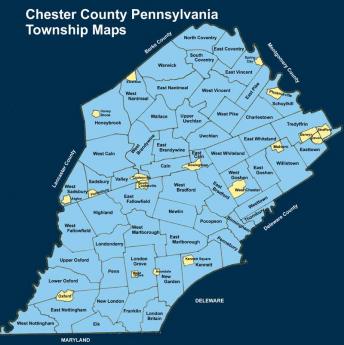
|
| Map of Chester County |
Chester County was one of the four original counties of Pennsylvania, as first laid out by its first white owner, William Penn. Although several parts of Chester County have been cut away, what's left is still quite large. Lancaster County was separated in 1729, and in 1785 Dauphin County was separated from that. In 1789, Delaware County was separated. If you stand in the horse country of Chester County, you still might find it hard to believe anything much has happened in three hundred years. But as a matter of fact, the present population residing within Penn's original boundaries of Chester County would make it the most populous county in the state and growing steadily. Since Philadelphia and Pittsburgh are meanwhile shrinking in population, projected future relationships would strike most residents of Chester County as quite remarkable. Horses, that's what Chester County wants to be all about. Even the mushroom growers of Kennett Square sort of count as part of the horse industry, because mushrooms are grown on horse manure, in the dark. Electronics and steel mills are not exactly traditional, but they reside here, too. As a small footnote, the Lukens Steel Company was recently purchased by an investor named Ross, who lumped it with several other steel mills and then sold the bundle to an owner in India. The consequence is that Chester has a footprint of the largest steel company in the world, or the largest steel company in India, whichever way you wish to style it. Nevertheless, the neighborhood still looks like horse country.
Furthermore, southern Chester County is socially part of the state of Delaware, while western Chester County is thoroughly Pennsylvania Dutch. Up north, the Philadelphia Main Line is building mansions as fast as mortgage originators will allow, and many of them end up paying Chester County taxes. All along Route 202, the central artery of the Great Valley, stretches a burgeoning electronics industry, within which is found Vanguard, the largest investment company in America, or possibly the second largest, depending on temporary quirks of mark-to-market pricing. Chester County presently has the highest average personal income of any county in America. It is far from true that everybody has a horse farm or a trust fund.
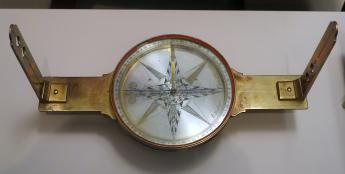
|
| David Rittenhouse's compass |
In a spiritual sense, Chester County horse culture contiguously spreads far beyond even historic outlines of Chester County. The boundaries of southeastern Pennsylvania were laid out with David Rittenhouse's compass, so the rolling hills suitable for horse farming extend into the states of Delaware and Maryland, and of course out into Lancaster and Dauphin counties, without much visible sign of individual state or county. In Europe, by contrast, almost all boundaries are set by rivers and mountain ranges, so the physical appearance of the countryside is apt to change sharply when crossing political borders. In fact, it is possible to say it in reverse: the State of Delaware is mostly Chester County extended, at least in its upper third. Below that lies urban and suburban Wilmington, and below that ("south of the canal") spreads loamy flat farm country, formerly slave country. Maryland divides similarly; an upper third of Maryland's rolling hillsides (sometimes known colloquially as Chester County extended), followed on the south by tidewater Maryland, in turn, followed by the suburbs of Washington, DC. The remnants of Baltimore are mixed in there somewhere, too. When you drive through miles of silent prosperous farms, regardless of highway signs, it is natural to think of yourself in the heart of America.
The one thing Chester County never much warmed to was Universities. It may shock residents of New York City to hear that Chester County never thought much of having its own art museums, classical music, theater performances or opera. However, Chester County doesn't share typical urban dislikes, either. Local speech patterns suggest Appalachian hillbillies and the Pennsylvania Dutch L'il Abners are just like us, just not so rich. Chester County sometimes thinks of itself as nobility, but it isn't Ivy League nobility, it's a country squire. We all like horses, dogs, and guns, we can't imagine why everyone else doesn't like them, too. Chester County has more history than almost anybody; it just doesn't talk much about it.
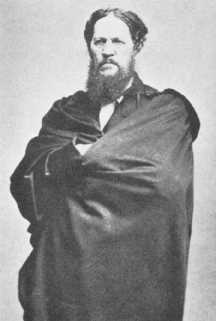
|
| Josiah Harlan |
So let's mention just the highlights: George Washington fought the battle of the Brandywine, the biggest battle of the American Revolution, in Chester County, the Paoli Massacre was long regarded as the second nastiest event of that campaign. A local farmer's son, Josiah Harlan (1799-1871), did what the Tsars and Dictators of Russia and the Kings and Queens of England couldn't do; he conquered Afghanistan. Moreover, he did it single-handedly, making himself King. Even the 350 American Rangers who conquered Afghanistan in 2002 can't match that exploit by this local Quaker boy. The first intern doctor of the first hospital in America (Jacob Ehrenzeller) spent his long life practicing in Chester County. The only President of the United States to come from Pennsylvania (James Buchanan) hailed from Lancaster, not terribly long after it split off from Chester County. In a wry sort of way, it can be said that Buchanan created the Republican Party by almost getting us to annex Cuba. Harrisburg, the present capital of the state, was once part of Chester County. Major portions of both British General Howe's and General Washington's armies left the Brandywine battlefield and swept up the Great Valley of Chester County to Philadelphia and Valley Forge, respectively. Conestoga Creek was once part of Chester County, and Conestoga wagons took many generations of settlers westward to build the new nation; wagons do go pretty naturally with horses. But drive through miles of Chester County today, usually alone through the silent stone barns and rolling grasslands: nothing much seems to have happened except real estate is more expensive.
But then, just drive up Route 202 from Wilmington to King of Prussia, at rush hour. This may be the Great Valley where Washington retreated to Valley Forge, but now it's where employees of the electronics industry ferry children to school, in order to get into the Ivy League, and maybe to shop at fancy stores in King of Prussia. With time out for a recession, it could be wall-to-wall McMansions around here in a generation. It seems almost certain the future will bear little resemblance to the past. It's sort of a pity, it is a great economic opportunity, and it seems inevitable.
Not a Single Red Knot
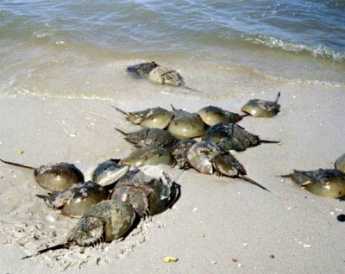
|
| Horseshoe Crabs |
A full moon brings high tide, which for centuries has brought vast numbers of horseshoe crabs to the banks of the Delaware River, toward the end of May. Marine biologists tell us these ugly-looking beasts have evolved very little for thousands of years.
Horseshoe crabs transport oxygen through their blood as a blue copper compound instead of that iron-containing hemoglobin the rest of us use. That's red, of course. Somewhere in the evolutionary path, these ancient animals also neglected to develop an immune system, but defend themselves against bacteria by precipitating sediment when they encounter endotoxin. By luck, this reaction takes place even though the bacteria are dead, so it is routinely employed as a way of detecting and eliminating endotoxin in intravenous fluids, which would otherwise go undetected by failing to grow the original bacteria in conventional culture media. Unfortunately, those of us who have never experienced a temperature spike to 106 degrees from an intravenous infusion of "sterile" water is more or less indifferent to the contribution of the Delaware crabs to our well-being. As well as being sadly indifferent to the unique nature of their nerve cells, in long single neurons, which make a number of important experiments possible.
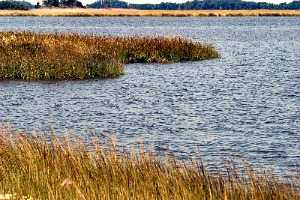
|
| Bombay Hook |
The horseshoe crab offers still other attractions. When they come ashore to lay eggs (at a full moon, or high tide, in May), they lay incredibly large quantities of them, attracting astonishing swarms of birds, which can be seen gliding a few feet above the water surface in groups of hundreds or even thousands. The Red Knot sandpiper is certainly not the only egg-eater at Bombay Hook, but there are some unique features of that bird to be mentioned in a minute. A lot of people object to being attacked by monster swarms of mosquitoes in the summer, but screens and air-conditioning have encouraged a large number of rather prosperous houses to be built along the shore, particularly where there are sandy beaches. In fact, it is so crowded the Fish and Wild Life Service has placed street lights at such public places, with a narrow driveway to lead you to the beach. If you don't know how to recognize such amenities, well, too bad for outsiders.
Although there are plenty of naturalists and bird-watchers who come in the early spring, most of the houses along "Slaughter Beach" seem to belong to fishermen and duck hunters, the two outdoor sports with most popularity. Different migrations of different food-producers bring different prey for the sportsmen, but somehow the most up-scale members of this fraternity tend to go there in May, looking for Red Knots. A Red Knot is a form of sandpiper, with a red head and breast. The birds are born in the Arctic tundra, eating vast amounts of mosquito eggs and larvae, migrating south in the fall. They winter over in Tierra del Fuego at the opposite end of the earth and then migrate north to Bombay Hook on Delaware. For these long migrations, they must eat voraciously when they do eat and somehow have learned to look for the horseshoe crab eggs at just the right time, presumably following cycles of the moon for timing. Residents of the area for centuries have remarked on the timing of the birds and the tides and the crabs. Unfortunately, the two-continent migration was only recognized fairly recently, and when the supply seemed endless, the crabs were scooped up and used for fertilizer until their supply began to dwindle; both Delaware and New Jersey now have protective legislation, and Virginia is being verbally excoriated by bird watchers, to do the same. The crabs have started to come back, but the Red Knots are slower to respond, and now the threat is Sushi. Another ecological damage has reduced the supply of crabs in the Pacific, so the crab fishermen have migrated to the Atlantic to catch the crabs as bait for conch and other ingredients of Sushi. Once again, the abundance of crabs has declined, although to a much smaller degree than the Red Knots. This year, on the very best day of the year for this sort of thing, with dozens of out-of-state license plates wandering aimlessly up and down thirty miles of shoreline, the shouted greetings among serious bird watchers returned the sad news, "No Red Knots today. Try the beach." It was generally agreed there was a bit too much wind for good Red Knot sighting, and that oil spills in the Gulf of Mexico were to be suspected, and that perhaps tomorrow would be a better day. But judging by the very expensive optical equipment these people were carrying around, these were serious birders, indeed. If they couldn't find Red Knots, the rest of us might as well give up.
The most plausible theory for the latest decline centers around the old-timer birds. When the first-timers start their northward migrations, they are guided by the old-timers who have made the trip at least once before. If something injures the flock, it may be a few years before the supply of old-timers revives enough to supply the first-timers with guides. That's just a theory, of course, but currently the most popular one. Just what it would take to eliminate the Red Knot migration completely, may now be close to being tested. Just on principle alone, it does seem a pity to eliminate a phenomenon which took thousands of years to develop.
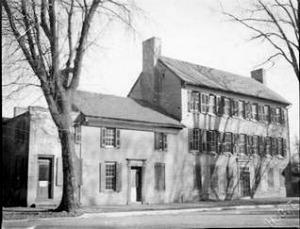
|
| Benjamin Chew's Whitehall |
When you finally give up on Red Knots, you might as well wander around this enormous wildlife sanctuary. A few miles up the road is the former location of Whitehall, the plantation house of Benjamin Chew, lawyer for the family of William Penn, and owner of the stone fortress on Germantown Avenue in Philadelphia that thwarted George Washington's attempt to stall and starve the British before they could join up with their ships in the harbor below Fort Mifflin. The original buildings on the plantation have disappeared, but the spongy plantation trails have been replaced by elevated gravel roads. So it is possible to roll up the windows of your car in mosquito season, turn on the air conditioning, and cruise around the spectacularly beautiful ponds and inlets. Further south is the plantation of Caesar Rodney, who rode to Philadelphia in the rain to cast the deciding vote for the Declaration of Independence. And further south of that is the plantation of John Dickinson, who made Rodney's ride necessary by refusing to sign the Declaration, on the grounds that the colonies showed insufficient unity, in his eyes, to be able to win a war with England. And anyway, the argument was largely economic, hence more likely to be won by economic means than military ones.
To the west of these historic plantations are some pretty impressive farms, new style. The houses give them away since no farmer will spend a cent on his house if he can profitably expand his farm; these houses belong in glossy magazines. The silos are grouped in clusters of ten or twelve, the irrigation sprinklers are a quarter-mile long, attachable to what resembles a fire hydrant in the center of the field. There are over a hundred sheds on some farms, filled with chickens fattening up. And do you know what? You can drive for miles without seeing a single chicken.
Eventually, the road leads to the Dover Air Force Base, very large indeed. No planes are in evidence, as is true on most days. But one day in 1962 Mr. Kennedy was talking to Mr. Castro, and overhead at Dover you could see dozens, maybe hundreds, of eight-engine bombers. Just circling, circling, waiting for orders to go lay an egg on the Kremlin. It wasn't clear to onlookers at the time, just what this was all about. But the idea can now be entertained that perhaps Red Knots weren't the only species flirting with extinction.
Relocation

|
| Moving Truck |
For many decades, at least since the Second World War, the Northeastern part of the country has been losing population. And business, and wealth. In recent years, New Jersey has been the state with the greatest net loss, and the Governor who is making the greatest fuss about it. Statisticians have raised this observation to the level of proven fact, although lots of people are even moving into New Jersey at the same time. This is a net figure, and it remains debatable what sort of person you would want to gain, hate to lose; so it's hard for politicians to be certain whether New Jersey's demographic shifts are currently a good thing or a bad thing.
Take the prison population, for example. Most people in New Jersey would think it was a good thing if the felons all moved to some other state because it would imply less crime and law enforcement costs. But one of the major recent causes of a decline in violent crime seems to be the universal presence of a portable telephone in everyone's pocket. Just let someone yell, "Stick 'em up!" loud enough, and thirty cell phones are apt to emerge, all dialing 911. On the other hand, cell phones are the universal communication vehicle for sales of illicit drugs and other illegal recreations, and the increase in automobile accidents is a serious business for inattentive drivers. Add to this confusion the data that capital punishment is more expensive for the State than incarceration is, and you start to see the near futility of knowing what is best to have more, or less, of.
What the Governor and his Department of Treasury mostly want to know is whether certain taxes end up producing a good net revenue for the State. That is, whether more revenue is produced by raising certain taxes more than others, or whether some taxes are a big component of the Laffer Curve, causing revenue to be lost by driving business, or business owners, out of state, in spite of the immediate revenue gain. The studies which have been done are fairly conclusive that executives tend to be most outraged by property taxes, since they have a hidden effect on the sale price of the house, and the amount of money available for school improvements. At least at present levels, a Governor is better off taking abuse for raising income or sales taxes, even though the apparent tax revenue might be the same as a rise in property taxes. Since property taxes are mostly set by a local municipal government, while sales and income taxes are usually set by state governments, a decision to raise one sort of tax or another can have unexpected consequences, or require obscure manipulations to accomplish.
Some politicians who believe their voting strength does not lie in the middle class, would normally want to hold up property values, not taxes because the data show that higher home prices drive away from the middle class and in certain circumstances are positively attractive to wealthy ones. Higher prices appeal to home sellers, at least up to a point. Wealthier people who are buying houses are likely to have an old one to sell; that's less true of first-time home buyers or people presently renting. Certain issues can even be reduced to rough formulas: a 1% increase in income tax would cause a 1% loss of population, but a 5% loss of people earning more than $125,000. A $10,000 increase in average home prices, on the other hand, causes a net loss of population, but mostly those with lower income. One important feature of tinkering with average home prices and property taxes is that these effects are "durable" -- they do not fade away over time.

|
| Laffer Curve |
New Jersey is financially a bad state to die in, but the decision to move to Delaware, Florida or Texas is often made over a long period of years in advance of actually doing it. It has been hard to compile statistics relating changes in inheritance tax law to net migration of retirees and to present such dry data in an effective manner to counteract the grumblings that rich people are undeserving of tax relief, or dead people are unable to complain. But rich old folks are very likely to own or control businesses, and if you drive them out of state, you may drive away a considerably larger amount of taxation relating to the business in other ways. This is the underlying complaint of Unions about Jobs, Jobs, Jobs; but state revenue also relates to sales taxes of the business, business taxes, employee taxes, real estate taxes on the business property, etc, etc. Sometimes these effects are more noticeable in the region they affect; the huge population growth of the Lehigh Valley in recent years is mainly composed of former New Jersey suburbanites, who formerly earned their income in New York. The taxes of three different states interact, in places like that.
The audience of a group I recently attended contained a great many people who make a living trying to persuade businesses to move into one of the three Quaker states of the Delaware Valley. The side-bar badinage of these people tended to agree that many of the decisions to relocate a business are based on seemingly capricious thinking. The decision to consider relocation to the Delaware Valley is often prompted by such things as the wife of an executive having gone to school on the Main Line. Following that, the professional persuaders move in with data about tax rates, average home prices, and the ranking of local school quality by analysts. Having compiled a short list of places to consider by this process, it all seemingly comes back to the same capriciousness. The wife of the C.E.O. had a roommate at college who still lives in the area. And she says the Philadelphia Flower Show is the best there is. So, fourteen thousand employees soon get a letter, telling them we are going to move.
And, the poor Governor is left out of the real decision-making entirely, except to the degree he recognizes that home property taxes have the largest provable effect on personal relocation. And lowering the corporate income tax has the biggest demonstrable effect on moving businesses. But the largest un-provable effect is dependent on the comparative level of the state's inheritance tax.
No Well-Run Hospital will Tolerate Bullet Holes
When they repaired our bullet hole at the Delaware Hospital recently, it was much more than a renovation of the clinic pharmacy. It symbolized a new generation assuming power in the hospital.
There were originally three bullet holes in the clinic: mine, Mrs. DuPont's, and the pharmacy. Mrs. DuPont and mine were quietly patched soon after the incident, but the small hole in the ceiling above the pharmacy window went unrepaired for ten years. That was not an oversight.
Hospital people who were active spectators of the shootout repeatedly protested any attempt to repair the small unobtrusive hole in the false ceiling, bothering no one but symbolic to a cluster of insiders. Even when the wing was completely gutted and renovated, that small patch of the ceiling was left untouched. Because some of us wanted it left alone, our wishes were respected in "our" hospital. The Delaware Hospital, you see, once experienced a shooting incident. It happened very much like a certain episode in the movie called “The Godfatherâ€, and indeed the recent criminals may well have got the idea from the movie. In any event, a very dangerous criminal was actually brought from prison to the hospital to have an x-ray. Ordinarily, prison authorities give inmates no advance notice they are going to the hospital. However, this prisoner was to have his gallbladder x-rayed. We don’t x-ray gallbladders this way very much at the present time (ultrasound examination has largely replaced x-ray) but in those days it was necessary to swallow several pills the night before, so the dye could have time by morning to concentrate in the gallbladder. Therefore, when the prisoner was given the pills to swallow, he knew he was going to the hospital in the morning. His buddies on the outside knew he was going too, and where he was going. How this grapevine works is, of course, a mystery, but it is natural to surmise some prison guard accepted a bribe.
So on a nice uneventful diabetic clinic morning at the hospital, the prison guards arrived with their manacled prisoner, marching him down the clinic corridor toward the x-ray department at the end of the hall. As this jaunty group passed the men’s room, the prisoner pleaded to be allowed to relieve himself. The guard went into the men’s room with him, unlocked his handcuffs, and waited. After washing his hands, the prisoner pushed a crumpled paper towel deep into the trash can, seized the gun which his buddies had previously hidden there, and wheeled around, shooting.
His getaway was well planned and smoothly executed. Everyone in the area dived for cover as he fired shots in random directions. By the time people began to peep, he had run down the hall, out the door, and into a waiting car. He was gone.
One of the volunteers in the clinic was a certain Mrs. DuPont, also a member of the board of trustees of the hospital. She was about thirty-five years old, surely one of the ten most beautiful women in the nation. How close the bullet really came to her I don’t know, but it was certainly closer than any bullet had ever come before, and she was scarce to be blamed for feeling she had a close call. My bullet was lodged in the wall a foot or so from the desk where I usually sat on Fridays, only this wasn’t Friday so I wasn’t there to have a close call. But if it had been Friday I might well have been sitting there, and I might well have had a close call. I mean, this event was really exciting.
So we all had a lot to talk about, with a lot of close calls we almost had. A group of old friends and old casual acquaintances were united in a shared experience which provided a welcome common topic of conversation. The doctors and the orderlies, the chambermaids and the heiress, the nurses and the administrative clerks, had a common event. Even if any of them manage to live another fifty years, I suspect they will rejoice in meeting anyone who can reopen the reminiscence.
The group had a strong sense of fraternity even before this notorious event, but it was formal. Titles were used, rules were pressed, formalities respected. The nurses wore the caps of their diploma schools, the volunteers wore pink aprons, the interns wore white suits. The attending physicians wore street clothes but they were a sort of uniform, too. In Wilmington, I wore a non-matching tweed jacket and grey flannel pants, like the other doctors. In Philadelphia, In some circumstances, it would have been a dark suit. The clinic ran by rules finely understood even if entirely unwritten. It was quite acceptable to ask Mrs. DuPont to dispose of a bottle of urine, but it would have been unthinkable to ask her to have lunch. We all nodded and smiled at each other in passing, but we didn’t chat except within our own groups. But the shooting episode was an enduring ice breaker. It was something you had in common with the clinic group, to which everyone else was an outsider. People retire, people, die, Times Change. New brooms sweep into administration and unknowingly sweep aside old icons. A new pharmacist regarded the bullet hole as a small curiosity which someone had told him about. A new head nurse had other things to worry about.
On the fourth or fifth time the contractors set about to patch the ceiling over the pharmacy window, no one of the original group was present to intervene. Since the area had been so totally renovated as to be almost unrecognizable as the old clinic with curtains between the beds, the little bullet hole was the last link with the past for the dwindling but still fairly numerous group of people who remembered another era. It is perhaps most forgivable for the heedless young professionals who bustle through the place, not to have known nor even to recognize the name of Dr. Lewis B. Flinn. Dr. Flinn died a few years ago, in his eighties, looking like a Roman Senator almost to the end.
Lew Flinn dominated the medical scene in the entire state of Delaware, but particularly in Wilmington, for sixty years. There were those who called him a dictator, but he was so universally revered it was difficult to find a single person who would criticize his decisions and actions. Some people, particularly the outs, the people who don’t count, resented his power and prestige. But in the thirty years, I knew him, I never heard of serious opposition to even one of his proposals. Lew Flinn can fairly be said to have transformed Delaware medicine from a second- rate hodgepodge into a professional environment of the first rank. Within the smallest state in the Union, he created the second largest private hospital in America. Late in his career, he investigated the idea of founding a medical school in Delaware and concluded without serious opposition that the quality of physicians in Delaware would be harmed by it. A new medical school takes time to amount to something and provides second-raters until it gets established. By contrast, Delaware was currently able to attract the cream of Ivy League schools to practice there, and it would be a step back to do anything but continue the process. There was nothing prideful in this conclusion, but there could have been. When Lew Flinn first came to Wilmington as a doctor he was diving into a pool of third rates, and misfits. Why in the world would an honor graduate of John Hopkins want to practice in Wilmington?
Lew Flinn was in fact such an honor graduate of John Hopkins that he eventually acquired certificate number one, of the American Board of Internal Medicine. With his training and natural ability, Flinn could have mattered anywhere he wanted to. He could have been successful in just about any medical career. Instead, he chose to come back to his home town. And make something of it.
Flinn had everything, absolutely everything. Wealth in the family, excellent connections, brains, and training. His manners were so instinctively gentlemanly that the simplest conversation would intimidate any awkward soul who was unable to match the occasion with the appropriate response. He could be brisk and disdainful, and commanding when the situation called for strength, but he seldom needed to call on anything but gentle persuasion.
However, of all the qualities which served him in his career of transforming Delaware medicine, surely the most important one was physical beauty. Eyebrows tend to rise at that kind of a statement. Nevertheless, a true understanding of the magnetic power of the man is best acquired by going to the Delaware Academy of Medicine building overlooking the pictures of former presidents. The first picture on the wall is of Lew Flinn, at perhaps age thirty. No movie star ever had a publicity picture taken which radiated a more electrifyingly handsome profile. When Lew Flinn approached a DuPont heiress with a request for money for the hospital, he got it. And his courtly manner turned the response of men from envy to admiration. If you want to get things done, look and act like that. While it was absolutely impossible to think of Flinn as a philanderer, it is easy to see why he was an irresistible medical evangelist.
Wilmington had four hospitals during the early decades of Flinn's career, and three of them were supported by different owners of the DuPont company. Flinn concentrated on the Delaware Hospital, but he also was active in promoting the Memorial and the Wilmington General Hospital. Eventually, he became chairman of the Department of Medicine of all Three. That may have seemed like a bit much to some of his colleagues, and at one point he was voted out, by the Medical staff of one of them. His power and prestige at the Delaware Hospital were never challenged, and he steadily built up its medical staff by recruiting specialists from out of town to came to Wilmington; I was one he recruited. He appeared out of the audience at a Chicago meeting where I gave a paper and invited me to have dinner with him. I can think of no other reason why he would have been at the meeting, and I heard similar stories from others who were recruited. I don’t believe he was ever paid a penny for his administrative work.
Flinn became a member of the board of trustees of the hospital, and from that position was able to advance the hospital in a number of ways. He knew what the town needed in the way of laboratories, equipment, and specialists. The trustees were guided into doing all the expensive things which make a hospital into one of the best in the country. He saw to it that the doctors were pampered. They had their own lounge and coat room, constantly supplied with hot coffee and daily newspapers. There was a separate doctors' dining room (the senior hospital administrators ate there too and were welcome members of the medical community), there were white table cloths. On Friday, fish day in that era, there was an oyster stew or lobster bisque. It was a great clubhouse to have around and it was so by design. It was lots of fun to come from Philadelphia, attend a doctor’s conference, work in the free clinic, and adjourn for lunch. Flinn built up a medical staff by courtesies when no other inducement would have done the job. We all liked each other.
It made Lew Flinn uneasy, to have to describe to other people what he was up to, what his plans were. If he proposed something, it was a proposal for immediate action and he meant to have it happen right now. On one occasion, though, he confided in me his philosophy of teaching programs for the internet and residents. He was not particularly interested in attracting resident physicians to the hospital, although they were welcome enough. The purpose of the teaching program for the interns was to serve as a framework for continuing education of the practicing physicians of the community. He fed them oysters to get them to come to the conferences and to have lunch with other practicing consultants in the dining room. You educated practicing doctors by asking them to help educate the interns.
After he retired, he embarked upon the project which was his greatest achievement, the unification of the three hospitals into the Delaware Medical Center. His reasoning was not so much that consolidation would reduce duplication of equipment, although that was an argument. The main need for a 1200 bed institution was to create pools of patients which were sufficiently large to make it possible for a specialist to make a living. When that was possible, Delaware could relax its constant recruitment efforts and expect the institution to generate a first class staff without subsidies or teaching salaries. It is my present information that this plan worked beautifully.
The new building, on ground donated by a DuPont widow, is a spectacular piece of hospital architecture. Money cannot buy a more sumptuous physical plant. One suspects Lew Flinn’s fundraising capabilities were a major factor in the lavishness, probably mostly through a spontaneous wish by his admirers to build a suitable memorial, to his memory.
My Years at Stockley
For forty-six years, I drove three hundred round- trip miles from Philadelphia to Stockley, Delaware -- once a month on Saturdays. That takes a whole day, so it kind of means I spent a year at sixty miles an hour, going and coming. In Delaware, they speak of going “South of the Canalâ€, to indicate the little state of Delaware is actually two states or at least two cultures. North of the Delaware-Chesapeake ship canal is the posh little city of Wilmington, where most of the major New York banks are moving to enjoy the special banking laws, and where the Dupont family held majestic court over its Ivy League Camelot. Wilmington has more lawyers than anywhere or at least more white shoe patrician lawyers than anywhere. Little Delaware generated special laws for the benefit of corporations, so a whole hive of corporation lawyers generated an industry of pretending that General Motors and IBM are headquartered there. Those lawyers were once so remote from the graduates of second-rate (i.e. state rather than national) law schools making a living as plaintiff lawyers, that even the doctors in Wilmington were on cordial terms with the Wilmington lawyers.
South of the Canal was something else. I saw burning crosses on several occasions, and my trip took me past two race tracks for horses and two for beat-up jalopies that smash into each other for the fun of it. To be fair about it, I was shot at twice, once below the canal, and once in Wilmington, that's another story. The incident below the canal was not terribly spectacular; I just heard a loud noise as I drove past Elks lodge, or maybe a Moose lodge, and there was a nice round hole in my fender when I got out of the car. I suppose someone in the lodge was just careless with his gun, but it is not impossible that I had crowded a pick-up truck which retaliated with fair warning.
I met a nice lady from Rehoboth who tells me she remembers when the highway was built; before 1930 or so, there was no road connecting lower Delaware with the outside world. The native people speak with an accent which isn't quite Southern and which is said to be very close to true Elizabethan English. The area was settled by Swedes before the English came, so the people are quite handsome in a sort of Daisy Mae, L’il Abner way. The highway has an interesting history. Coleman DuPont purchased the land and built the highway at his own expense. If you know anything about rural legislatures, you can guess what happened next. He offered the highway to the State and the legislature refused to accept the maintenance costs. When he then hired his own police force to patrol the highway, the legislature reconsidered and accepted his offer to give them the highway.
My trips to this area have their destination at the Hospital for the Mentally Retarded in Stockley, Delaware. In spite of the way it is spelled, it is pronounced "Stokely". A state cop once forgave my speeding violation when I told him I had been at "Stokely". He said that in spite of my out-of-state license plates, I must be telling the truth if I knew how to pronounce it. The hospital has always kept a sign-in log in the administration building, and it is fun to see my signatures going back to 1958, month after month. I've had a couple of close calls or near-accidents on the highway which I haven't told my wife about, and on two occasions the ice or fog was so bad I had to turn around and come home without completing the trip. The trip ordinarily isn't so bad. The car is on cruise control, there are medical education tapes to play (Audio Digest, courtesy of the California Medical Association), and a sort of hypnosis makes you forget where you are going until you get there.
The medical director is a nice young fellow who has a practice in a nearby (25 miles) town and stops by for a few hours a day. Except for him, just about every resident doctor in thirty years has been foreign-born, and I would judge, very poorly paid. So, several years before I came to Stockley, someone had the idea of bringing in consultants from Wilmington, Philadelphia, and Baltimore. In the early days that was reasonably easy to do, because the hospital was filled with six hundred perfectly fascinating cases. I've seen several albinos and one thirty-year-old who was no bigger than an infant in arms. They used to have a number of cases of grotesque hydrocephalus, where the poor child grew a head larger than you could put your arms around and which would develop huge bedsores because the child couldn't move his head, let alone lift it. Because the Delmarva Peninsula has been a closed society for over three hundred years, there are lots of cases of rare inherited diseases. I have seen many cases of disorders that other doctors have only maybe read about, and I must admit I loved the experience.
But you know after you spend as much time with them as I have, they stop being interesting cases and become individuals, with names and personalities. Since the aging process is accelerated in several common diseases like Mongolism, I have known some of the patients' as little children, then as adults, and finally as dying withered victims of senility. Many times, I have watched the central agony of mental retardation; the children inevitably outlive their parents and ultimately have no one to love them except the institution.
In that role, Stockley does pretty well, although perhaps not as well as it used to do. The switch seems to have happened with the John Kennedy administration when money for the retarded became abundant. That landmark was especially memorable on a Saturday when the Russians menaced us over Cuba. I never knew we had so many eight-engined bombers as circled over the Dover Air Force Base that day. Years later, a pilot brought his son to see me, and I asked him. "Yup," he said. "we were carrying eggs, all right." "Picked them up in Alaska."The Proprietorships of William Penn
William Penn became first interested in the Colonies when he acquired New Jersey as an investor in what started out as the bankruptcy proceedings of a client. Unlike his spoiled children and grandchildren, he was sincerely interested in helping the persecuted members of his new religion, and those who later totaled up his lifetime finances found that overall he lost money on his real estate ventures. His descendants, however, were mainly concerned with selling real estate, and soon reverted to Anglican church membership. When William Penn later received Pennsylvania and Delaware from the King of England (Charles II, the Stuart King restored with the help of his Admiral father), he not only owned these territories but for practical administrative reasons was offered the right to rule them. By then Penn's main future intention was to found a refuge for Quakers and other religious dissenters, so becoming a vassal King was graciously declined. Instead, he became a real estate Proprietor, after satisfying himself about the government and other arrangements in only a general way. At least half the original 13 colonies were also proprietorships, although the terms of their grants had great variation. Penn's intention for the proprietorship was to sell off as much of the property as possible, sort of benignly watching the process unfold in the parts he had sold.
There were two unforeseen flaws in this benevolent idea; the first was that his sons and heirs would abandon the Quaker faith and have little interest in his holy experiment except for the revenue it returned. The second flaw was to fail to see that vigorous religious toleration might eventually lead to the Quakers becoming outnumbered in their own refuge. Eventually, there does come a time in the real estate sell-off process when you have sold more than you retain. After that point, you may no longer dominate the politics, and in fact, that happened far sooner than half-way, because of Penn's unwillingness to employ force .
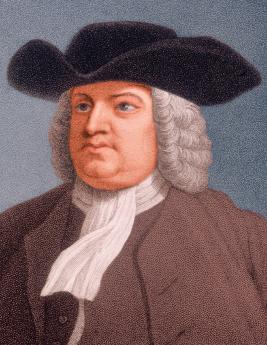
|
| William Penn |
In land value, although perhaps not in land area, that point of loss of control had been reached by the middle of the eighteenth century, and it led to a famous battle between the Penn descendants and Benjamin Franklin. The Penn family saw no justice in paying taxes on the land they hadn't yet sold, or obeying laws created by their customers which extended beyond the land they owned; if they wanted to rule it all, they should buy it all. Franklin took the part of the settlers and immigrants, who resented paying taxes and fighting Indians on behalf of someone who still owned vast stretches of the land "within" the colony. A significant factor in this peculiar argument is that Thomas Penn, the dominant chief of the family descendants, had a deep and abiding suspicion of Franklin, dating back to that episode related in Franklin's Autobiography where Franklin raised a militia in King George's War when the pacifist Quakers refused to do so. Both sides had some justice in their positions, both sides appealed to the King. The Penns knew the King better, so Franklin lost. That was mostly what Franklin was doing in London in the years before the Revolution, and eventually, it took a Revolutionary war to resolve the issue. Some have said the episode showed Franklin was not as shrewd a politician as history books would portray him. In fact, it more likely emphasizes that Franklin was a loyal British subject right up to 1775. His position was that all parties were and forever would be, inhabitants of the British Empire, so they had equality under British rule. The Penns felt they had a right to consider Pennsylvania their own sovereign property, under which the colonists had no rights until they paid for them. It is easy to see how the notion of independence could take hold in this curious reversal of roles. Nevertheless, Pennsylvania did resolve the issue with the appearance of lawfulness, although with restrained generosity. To quote Sydney G. Fisher, writing in The Quaker Colonies, "When the people could have confiscated everything in Pennsylvania belonging to the proprietary family, they not only left them in possession of a large part of their land but paid them handsomely for the part that was taken." The matter is generally considered to have been finally settled by the Confirming Act of 1787, although few would now contend that fifteen pennies per acre is or was a handsome price.
And so, the Pennsylvania proprietorship was dissolved. In New Jersey, on the other hand, the proprietorship still exists. The land between the North River (Hudson) and the South River (Delaware) was divided into two proprietorships by a line drawn between the Delaware Water Gap, and Beach Haven on Long Beach Island. The southern segment was called the Proprietorship of West Jersey, informally peopled by English Quakers, and a northern half, the Proprietorship of East Jersey, informally ceded to Scots Quakers who proved to be more Scottish than Quaker. Temperamental differences might well have eventually led the two segments to take opposite sides of the 1860 Civil War except that it was the northern half that sympathized with slavery and the Southern Confederacy, while the Proprietorship of West Jersey was mostly where the anti-slavery movement began, with a Quaker named John Woolman. As matters turned out, neither slavery nor taxing unsold land became irreconcilable issues in the Jerseys. Unsold land of the Proprietorship was already fairly minor in New Jersey at the time of the Revolution, but the issue hadn't been forgotten by the Proprietors, either. A couple of the stockholders of the proprietorship were members of the Constitutional Convention. When the time came that other delegates urgently needed New Jersey's vote to ratify the new constitution, the Proprietor problem was "explained" to the other states. The outcome was that the proprietorship tacitly agreed to be taxed and regulated like any other property owner, while their own rights were respected as persisting under the new Constitution. Such a sensible outcome was probably not possible in Pennsylvania because there was so much more unsold land to fight about. The peacefully accepted consequence in New Jersey, even today, is that when the ocean creates a new strip of beach or a farmer abandons some land on the other side of a turnpike, it reverts to the Proprietorship as undeeded and untitled land. As such, it legally belongs to a little group of stockholders who meet once a year in Burlington or Salem, under a tree, and who can actually pay themselves annual dividends. It is however only true in half the state; the Proprietorship of East Jersey surrendered its rights to the State in 1998.
In Delaware, things are a little fuzzier. Delaware was once part of Pennsylvania, as its lower three counties. John Dickinson was once Governor of both states, but they had two legislatures from 1700 to 1776. The last time the proprietorship matter came up, so far as real estate lawyers can remember, was in the shifting sandy beaches of Cape Henlopen; things were smoothed out by making the disputed land into a state park.
REFERENCES
| Encyclopedia of New Jersey | Google Books |
| The Problem of West Jersey | JSTOR |
| The Oxford History of the British Empire: The Origins of the Empire | Google Books |
| A Map of East and West New Jarsey | JPG |
| Council of Proprietors of West Jersey | westjersey.org |
| Magna Charta: Part I: The Romance of the Great Charter; Part II: Pedigrees of the Barons: John S. Wurts: SIN: AB0006D91C4 | Abe Books |
| West New Jersey: The Peculiar Province: ASIN: B00072HGTE | Amazon |
| Why the Private School?: Allan V. Heely: ASIN: B000GR1QS2 | Amazon |
Concessions and Agreements
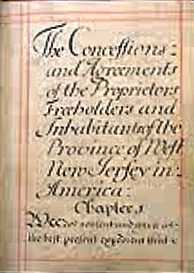
|
| Concessions and Agreements |
The United States Constitution is a unique achievement, but it had significant precursors, many of which James Madison had studied at Princeton. In the days of difficult ocean travel, almost all colonies were bound by an agreement to maintain loyalty to their European owners in spite of receiving latitude to govern themselves. Charters and documents defining these roles were generally written by the owners, and the colonists could pretty much take them or leave them. In the case of New Jersey in 1664, however, a very formidable lawyer and friend of the King named William Penn was drawing up agreements to his own conditions of sale, taking care that the grant of governing authority he received was favorable. Penn's relationship to the King was unusually good, to say the least. He had more reason to be wary of nit-pickers in the King's administration, trying to anticipate every conceivable disappointment for some successor King.
For his part, Penn wanted to make colonial land attractive to re-sell to religious groups who had experienced harsh government oppression; he wanted no obstacles to his announcing there would be no religious oppression in New Jersey. He was offered the role of sub-king although he hastily rejected any such title, and needed to repeat the formalities of the Charter to define his role and reassure his settlers about that matter. Furthermore, he was dealing with the heirs of Carteret and Berkeley, active participants in North and South Carolina. So Penn's method of achieving basic rights was influenced by prior thinking in the Carolinas, as the thinking of John Locke secondarily influenced matters in Delaware and Pennsylvania. These ideas were incorporated in a New Jersey document called "Concessions and Agreements." The concepts were not wholly the ideas of William Penn, but he did write it, and it does contain many ideas that were uniquely his. Understandings about limits were set down, argued about, and agreed to. The owner risked money, the colonist risked his life. Neither would agree unless a reasonable bargain was struck in advance of any dispute. Furthermore, the main value of a colony was beginning to shift from trading rights to real estate rights. Carteret and Berkeley had not only been principals in both the Carolinas and the Jerseys but had been involved in a number of such investments in Africa and the West Indies; New Jersey was just another business deal. It was conventional for documents of this type to define the method of selection of a governor, the establishment of an assembly of colonists, and some sort of council to attend to day to day affairs. In that era, few colonists would cross the ocean without a guarantee of religious freedom, at least for their own brand of religion. Standard clauses which may sound strange in today's real estate world, were then necessary because it was a transfer of not merely land, but also the terms of government. In the case of the Quaker colonies, many of these stipulations were included in the earlier charter from the King. It seems very likely that Penn hovered around and negotiated these points which he wished to have the King agree to; and then once the land was safely his, Penn repeated and expanded these stipulations with the colonists in his Concessions and Agreements . It wasn't exactly a Constitution, but it reads a lot like the one America adopted a century later.
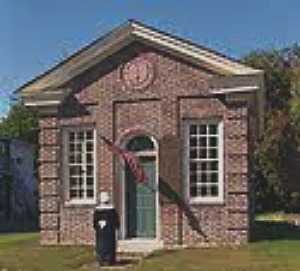
|
| Proprietors House |
Quakers had suffered persecution and imprisonment, and knew exactly what they feared; on the other side, it seems likely Carteret and Berkeley were less interested. So this real estate transfer document conceded almost anything the colonists wanted and the King would stand for, couched in conciliatory phrases. For example, no settler was to be molested for his conscience, and liberty was to be for all time, and for all men and Christians. Elections, by the way, must be annual, and by secret ballot. While law and order must prevail, nevertheless no man is to be imprisoned or molested except by the agreement of twelve men of the neighborhood. On the matter of slavery, no man was to be brought to the colony in bondage, save by his own consent (that is, indentured servants were to be permitted). And in what proved to be a final irony for William Penn, there was to be no imprisonment for debt. Almost all of these innovative ideas survived into the U.S. Constitution a century later, but the most innovative idea of all was to set them all down in a freely-made agreement in writing. This was not merely how a government was organized, it defined the set of conditions under which both sides agreed it would operate.
It was, of course, more than that. It was a set of reassurances to settlers who had been in New Jersey before the English arrived that they, also, would be treated as equals. It was a real estate advertisement to the fearful religious dissenters back in England that it was safe to live here. And it was a reminder to future Kings and Parliaments that this is what they had promised.
The pity and a warning, is that the larger vision of a whole continent governed fairly by common consent may have been too grandiose for a little band of New Jersey Quakers, surrounded as they were by an uncomprehending world. All utopias are helpless when stronger neighbors reject the basic premise. However, it was the expansion of the pacifist concept to the much larger neighboring territory of Pennsylvania that proved to be just too much for such a small group of friends to manage by consensus, particularly when unbelieving immigrants began to outnumber them. But the essential parts of it certainly remained in the minds of delegates to the Constitutional Convention in 1787. When the minutes of the Constitutional Convention speak of the "New Jersey Plan", the Concessions and Agreements was what they had in mind.
REFERENCES
| Concessions and Agreements of New Jersey 1676: William Penn | New Jersey State Library |
| Camden After the Fall: Decline and Renewal in a Post-Industrial City: Howard Gillette Jr.: ISBN-13: 978-0812219685 | Amazon |
| Posted by: ALBERT GUILLEN | Mar 20, 2018 3:42 AM |
| Posted by: Nash | Jan 3, 2012 1:24 PM |
To answer your question more directly, you might have to go to Lloyds of London for something immensely valuable. For lesser things, a personal property policy from almost any big casualty insurer would be all right, providing you took the trouble to specify the particular items in your "floater" policy.
| Posted by: George Fisher | Apr 17, 2008 3:33 PM |
| Posted by: Amanda | Apr 17, 2008 1:53 AM |
| Posted by: Florence Wiley | Sep 17, 2007 4:31 PM |
37 Blogs
Delaware Bay Before the White Man Came
 This was the last major place on the East Coast to be settled because it was a swampy snaggy pond, full of fish and birds. And soon, pirates.
This was the last major place on the East Coast to be settled because it was a swampy snaggy pond, full of fish and birds. And soon, pirates.
Forming the State of Delaware
 In 1632, King Charles I granted to the Maryland proprietor coastal land with a northern border at the 40th parallel. In 1682, his son James the Duke of York evicted the Dutch from the Connecticut River to Cape Henlopen; afterward, his brother King Charles II gave away New Jersey and Pennsylvania, leaving York with New York plus a strip of wilderness from Pennsylvania to Henlopen. York then gifted that southern strip to William Penn before anyone realized there was a sloppy overlap with Maryland of thousands of square miles. Lawsuits are galore.
In 1632, King Charles I granted to the Maryland proprietor coastal land with a northern border at the 40th parallel. In 1682, his son James the Duke of York evicted the Dutch from the Connecticut River to Cape Henlopen; afterward, his brother King Charles II gave away New Jersey and Pennsylvania, leaving York with New York plus a strip of wilderness from Pennsylvania to Henlopen. York then gifted that southern strip to William Penn before anyone realized there was a sloppy overlap with Maryland of thousands of square miles. Lawsuits are galore.
Boundaries of the Grant of Pennsylvania
The land granted to Penn was mostly swamp and wilderness in the 17th Century. Infinite disagreements were certain to result, but a paragraph described all that could be known at the time of the grant.
Pennyslvania's Boundary: David Rittenhouse, Hero, Lord Baltimore, Villain
 Because a local genius invented and perfected surveying instruments, America is one of the few nations in the world with straight-line boundaries.
Because a local genius invented and perfected surveying instruments, America is one of the few nations in the world with straight-line boundaries.
Pirate Lair
 Did Blackbeard use the Delaware marshes as a hideout?
Did Blackbeard use the Delaware marshes as a hideout?
Delaware Declares Independence ... From Pennsylvania
 To the despair of its school teachers, few Delaware citizens know or care how Delaware split off from Pennsylvania when William Penn owned them both. In fact, he also owned New Jersey.
To the despair of its school teachers, few Delaware citizens know or care how Delaware split off from Pennsylvania when William Penn owned them both. In fact, he also owned New Jersey.
Delaware's Court of Chancery
 Georgetown, Delaware is a pretty small town, but it's where the major corporations of the nation plead their case.
Georgetown, Delaware is a pretty small town, but it's where the major corporations of the nation plead their case.
Tony Junker: Tunnell's Boys
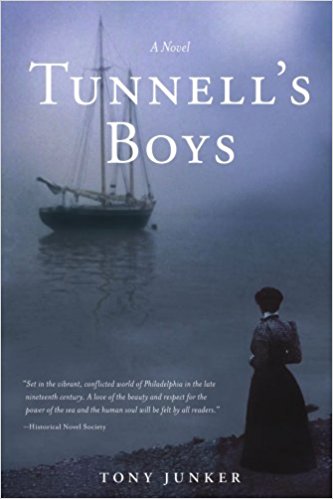 Pilots once had to race from the mouth of Delaware Bay to meet incoming ships. First one there got the job.
Pilots once had to race from the mouth of Delaware Bay to meet incoming ships. First one there got the job.
Elizabethan Accents in Philadelphia
 In the birthplace of American independence, there's still a lot of Olde English buried in the speech patterns.
In the birthplace of American independence, there's still a lot of Olde English buried in the speech patterns.
Georgetown Oyster Eat: Separate but Equal
 The Delaware Bay once teemed with Oysters, and local firehouses were supported by annual oyster festivals. A few places bravely keep up the tradition.
The Delaware Bay once teemed with Oysters, and local firehouses were supported by annual oyster festivals. A few places bravely keep up the tradition.
Caesar Rodney Rides Through the Rain
 When it looked as though Delaware was wavering on the Declaration of Independence, Caesar Rodney was summoned to ride through the rain to cast a deciding vote, in spite of advanced cancer of his jaw.
When it looked as though Delaware was wavering on the Declaration of Independence, Caesar Rodney was summoned to ride through the rain to cast a deciding vote, in spite of advanced cancer of his jaw.
John Dickinson, Quaker Hamlet
 John Dickinson was the most respected lawyer and politician of his time. He had a lot to do with writing the Declaration of Independence but refused to sign it.
John Dickinson was the most respected lawyer and politician of his time. He had a lot to do with writing the Declaration of Independence but refused to sign it.
Aftermath: Who Won, the States or the Federal?
 The auto and the jet plane changed all the rules of the American Constitution of 1787. Curiously, canals were central to the Peace of Westphalia of 1648, the other great political innovation of modern times.
The auto and the jet plane changed all the rules of the American Constitution of 1787. Curiously, canals were central to the Peace of Westphalia of 1648, the other great political innovation of modern times.
A Pennsylvania Farmer in Delaware
 John Dickinson achieved national fame in 1773 by publishing twelve letters written earlier denouncing the Townshend Acts. They were published anonymously as Letters From a Pennsylvania Farmer. His farm, curiously, was in Delaware.
John Dickinson achieved national fame in 1773 by publishing twelve letters written earlier denouncing the Townshend Acts. They were published anonymously as Letters From a Pennsylvania Farmer. His farm, curiously, was in Delaware.
Georgetown Returns Day
 Glimpse what American democracy was supposed to be in the little Delaware village of Georgetown, even after nearly three centuries have gone by. Two days after the election, the victorious and the defeated candidates still appear for announced election results, ride around the courthouse in a carriage together, and actually bury a hatchet.
Glimpse what American democracy was supposed to be in the little Delaware village of Georgetown, even after nearly three centuries have gone by. Two days after the election, the victorious and the defeated candidates still appear for announced election results, ride around the courthouse in a carriage together, and actually bury a hatchet.
Odessa, Delaware
 Rodney Sharp fixed up his old home town, and it's an architectural jewel worth visiting. Christmas is the best time.
Rodney Sharp fixed up his old home town, and it's an architectural jewel worth visiting. Christmas is the best time.
New Castle, Delaware
 A short history of a historically significant town, now off the beaten path.
A short history of a historically significant town, now off the beaten path.
Pea Patch Island
 A string of three forts at the level of the Delaware-Chesapeake Canal once guarded the approaches to Philadelphia but were never needed. After the Battle of Gettysburg, Fort Delaware on Pea Patch Island served as a deplorable prison camp for Confederate prisoners; it's now a tourist stop.
A string of three forts at the level of the Delaware-Chesapeake Canal once guarded the approaches to Philadelphia but were never needed. After the Battle of Gettysburg, Fort Delaware on Pea Patch Island served as a deplorable prison camp for Confederate prisoners; it's now a tourist stop.
Getaway
 The Delaware Hospital in Wilmington once had a real shoot-out.
The Delaware Hospital in Wilmington once had a real shoot-out.
Brandywine Museum
 The Wyeths, one of the great artistic families of America, display their work in the Brandywine Museum, which is itself a work of art.
The Wyeths, one of the great artistic families of America, display their work in the Brandywine Museum, which is itself a work of art.
Fanny Kemble Takes the Train South, in 1838
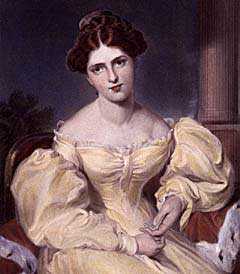 One of several important and influential books that Fanny wrote described her trip from the Philadelphia salons to the slave quarters of Georgia. It's well worth reading, even today.
One of several important and influential books that Fanny wrote described her trip from the Philadelphia salons to the slave quarters of Georgia. It's well worth reading, even today.
Battle of the Clouds: September, Remember
 Benjamin Franklin, it should be noted, was the first to observe that Atlantic Coast "Nor'easters" actually begin in the South and work North, even though the wind seems to be blowing the other way.
Benjamin Franklin, it should be noted, was the first to observe that Atlantic Coast "Nor'easters" actually begin in the South and work North, even though the wind seems to be blowing the other way.
Day Two: Rehoboth to Kennett Square
 The southwestern shore of Delaware Bay was an isolated swampy world until a couple of decades ago. It now seems to hurtle toward a resemblance to Luxembourg or Liechtenstein. Any way you look at it, the State of Delaware is very charming.
The southwestern shore of Delaware Bay was an isolated swampy world until a couple of decades ago. It now seems to hurtle toward a resemblance to Luxembourg or Liechtenstein. Any way you look at it, the State of Delaware is very charming.
Philadelphia Gardens
 Philadelphia loves its gardens, particularly boxwood and azalea.
Philadelphia loves its gardens, particularly boxwood and azalea.
Secret Places
 Some rich people are ostentatious about where they live. In Philadelphia, they are more likely to go into hiding, but in special places.
Some rich people are ostentatious about where they live. In Philadelphia, they are more likely to go into hiding, but in special places.
Furniture for the Horse Country
 Fine art is generally the product of rich people demanding something special from a nearby artisan community. Furniture making in Chester County is sort of like that.
Fine art is generally the product of rich people demanding something special from a nearby artisan community. Furniture making in Chester County is sort of like that.
Hedge Funds in Delaware
 The state of Delaware attracts clusters of businesses for reasons having to do with its legal system; call it Delaware Attractiveness. At the moment, it attracts hedge funds.
The state of Delaware attracts clusters of businesses for reasons having to do with its legal system; call it Delaware Attractiveness. At the moment, it attracts hedge funds.
Go to Delaware, Elephants?
 It's about a 20-minute commute from Delaware to Philadelphia, with a big difference in estate taxes. Moving from New Jersey to Delaware would double that difference.
It's about a 20-minute commute from Delaware to Philadelphia, with a big difference in estate taxes. Moving from New Jersey to Delaware would double that difference.
Port of Philadelphia
 The Port of Philadelphia has access to six U.S. Senators from its surrounding states, but the price to be paid is endless political wrangling.
The Port of Philadelphia has access to six U.S. Senators from its surrounding states, but the price to be paid is endless political wrangling.
Delaware to do
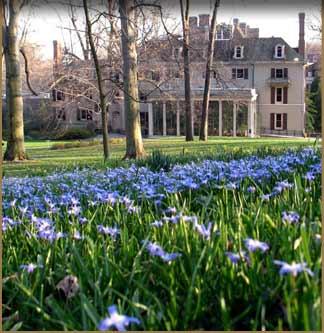 Longwood or Winterthur?
Longwood or Winterthur?
Chester County, Pennsylvania
 When you say Chester County, you are probably talking about horses. There's much more to say.
When you say Chester County, you are probably talking about horses. There's much more to say.
Not a Single Red Knot
 Between the Dover Air Force Base and the west bank of the Delaware River is a large area of wetland and fertile soil centered on what is called the Bombay Hook. Benjamin Chew, Caesar Rodney, and John Dickinson all had extensive plantations there. In some ways, remarkable wealth is all centered on the fertility deposited over the centuries by the eggs of horseshoe crabs along the bank
s of the river.
Between the Dover Air Force Base and the west bank of the Delaware River is a large area of wetland and fertile soil centered on what is called the Bombay Hook. Benjamin Chew, Caesar Rodney, and John Dickinson all had extensive plantations there. In some ways, remarkable wealth is all centered on the fertility deposited over the centuries by the eggs of horseshoe crabs along the bank
s of the river.
Relocation
 Moving your place of residence has many influences, but property taxes seem to have the biggest influence on business executives decided to move. By contrast, property prices have the biggest influence on the middle class.
Moving your place of residence has many influences, but property taxes seem to have the biggest influence on business executives decided to move. By contrast, property prices have the biggest influence on the middle class.
No Well-Run Hospital will Tolerate Bullet Holes
One by one, the holes got patched over.
My Years at Stockley
New blog 2018-08-22 22:39:22 description
The Proprietorships of William Penn
 William Penn owned Pennsylvania, New Jersey, and Delaware; as the proprietor, he was the largest private American landowner, ever. Although the Revolutionary War mostly ended that, one of his proprietorships still owns all unclaimed land in southern New Jersey.
William Penn owned Pennsylvania, New Jersey, and Delaware; as the proprietor, he was the largest private American landowner, ever. Although the Revolutionary War mostly ended that, one of his proprietorships still owns all unclaimed land in southern New Jersey.
Concessions and Agreements
 Most 17th Century colonies were proprietorships, requiring agreements for local autonomy without losing allegiance to the home country. William Penn cleverly expanded the New Jersey document into the intellectual precursor of the U.S. Constitution.
Most 17th Century colonies were proprietorships, requiring agreements for local autonomy without losing allegiance to the home country. William Penn cleverly expanded the New Jersey document into the intellectual precursor of the U.S. Constitution.
